March 1 - 7, 2020: Issue 440
Manly Children's Festival Federation Of A Commonwealth Medals Of 1901: Collecting Commemorative Medals
When collecting medals there are a few guidelines which apply here as much as when collecting anything else; Study the history, military or otherwise, and look for examples so you know what you're trying to acquire. Pay the right price. Treat them with respect and look for high quality examples without marks, tarnish, scratches. Don't be afraid to speculate. And;- Choose a collecting focus.
One area that has become more and more popular is, alike those of early Trade Tokens or earlier Australian coins, Commemorative Medals. A quick look online for medals or awards or those struck to mark significant occasions and it will quickly be evident this is a huge collecting field. As with all these instances those that are close to home or give insight into something that affected those who came before us will always garner more attention than something we have no direct or family connection to.
Known by collectors as Portrait or Art medals, Portrait medals were developed during the Italian Renaissance and are central to the history of European portraiture, flourishing as an art form through the nineteenth century and into the twentieth century. Though less familiar to us now than painting and sculpture, these exquisitely crafted objects, typically made from lead, bronze, silver or gold, were produced (sometimes in large numbers) to commemorate individuals, to acknowledge special events, and to disseminate the identity and power of their sitters.
One such major Collection, the Stephen K. and Janie Woo Scher Collection, is considered the world’s greatest private collection of portrait medals, rivalling many collections in international museums. A tome filled with all Collection is available to purchase.
There are also websites available through which you can find out more before you venture into selecting your first Commemorative medals, the website 'Historical and Commemorative Medals - Collection of Benjamin Weiss' offers great insights on medals, auctions, appraisers, dealers and other medal collections on the Web.
The example shared here has a direct connection with our area in that Pittwater children attended an event at Manly and were issued with a Federation of Australia Commemorative Medal struck especially for and as part of those festivities.
Australia became a nation on January 1st 1901, when the British Parliament passed legislation enabling the six Australian colonies to collectively govern in their own right as the Commonwealth of Australia. It was a remarkable political accomplishment that had taken many years and several referenda to achieve. The Commonwealth of Australia Constitution Act (UK) was passed on 5 July 1900 and given Royal Assent by Queen Victoria on July 9th 1900. It was proclaimed on January 1st 1901 in Centennial Park, Sydney. Sir Edmund Barton was sworn in as the interim Prime Minister, leading an interim Federal ministry of nine members.
The new constitution established a bicameral Parliament, containing a Senate and a House of Representatives. The office of Governor-General was established as the Queen's representative; initially, this person was considered a representative of the British government. The Constitution also established a High Court, and divided the powers of government between the states and the new Commonwealth government.
The site of a federal capital was disputed heavily between the two arch-rivals Sydney and Melbourne; the compromise was that a separate territory (the Australian Capital Territory) would be established within New South Wales to hold a new capital, while Parliament would sit in Melbourne until the new city was constructed. The site eventually chosen for the city became Canberra.
As part of the celebrations pageants, parades and festivals took place in Sydney associated with the January 1st Centennial Park Proclamation - some of which involved children - one memorable one being that held at the Sydney Cricket Ground in which students from Manly and Mosman schools were included. Pittwater Online has previously run a few photos of this taken by a member of the Macpherson family of Warriewood.
PUBLIC SCHOOLS' DISPLAY, SYDNEY CRICKET GROUND, JANUARY 3, 1901.
ONE event in the general catalogue of celebration which will be remembered for many years by the thousands who witnessed it was the Public Schools display on the Sydney Cricket Ground.
...
SCHOOLS REPRESENTED.
Annandale, Ashfield. Auburn, Auburn North, Albion-street, Arncliffe, Banks Meadow, Bondi, Birchgrove, Belmore, Botany, Burwood, Blackfriars, Balmain Camdenville, Camperdown, Canterbury, Cleveland-street, Croydon, Croydon Park, Coogee, Chatswood, Carlingford, Castlereagh-street, Crown-street, Dulwich Hill, Darlinghurst, Darlington, Drummoyne, Double Bay, Darling-road, Enmore, Erskineville, Ermington, Fort-street Model school, Lower Fort-street, Forest Lodge, Gardener’s-road, Granville, Granville North, Gladesville, Glebe, Glenmore-road, Greenwich, Gordon, Hunter's Hill, Hurstville West, Homebush, Hornsby, Hurstville, Hurslstone Practicing, Kogarah, Kegworth, Leichardt, Leichhardt West, Marrickville, Marrickville West, Macquarie-street South, Manly, Mosman, Naremburn, Nicholson-street, Newtown, Newtown North, Neutral Bay, Parramatta North, Parramatta South, Peakhurst, Petersham, Pyrmont, Penrith, Plunkett-street, Pitt Row, Paddington, Redfern, Richmond, Ryde North, Ryde, Rockdale, Redfern West, Rookwood, Randwick, Summer Hill, Sandringham, Stanmore, Smith-street, Sutherland, St. Peters. St. Ives, St. Leonards East, St. Leonards, South St. Leonard's, Sussex-street, Surry Hills South, South Strathfield, Thornleigh, Toongabbie, Tempe, Ultimo, Watson's Bay, Waverley, Woolwich, Waterloo, William -street. Willoughby, 'Windsor, Woollahra.
.jpg?timestamp=1582929568364)
FEDERATION GROUP BY THE HURSTVILLE SCHOOL.
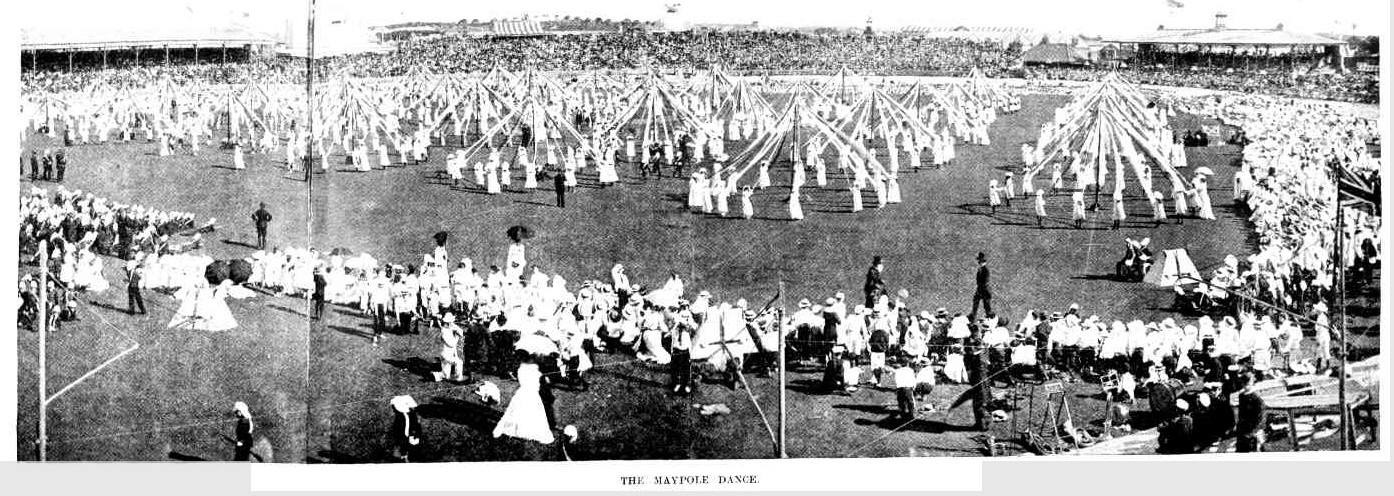
THE MAYPOLE DANCE.
.jpg?timestamp=1582929696074)
COMBINED SCHOOLS MUSICAL DRILL.
PUBLIC SCHOOLS' DISPLAY, SYDNEY CRICKET GROUND, JANUARY 3, 1901. (1901, January 12). The Sydney Mail and New South Wales Advertiser (NSW : 1871 - 1912), p. 92. Retrieved from http://nla.gov.au/nla.news-article165295937
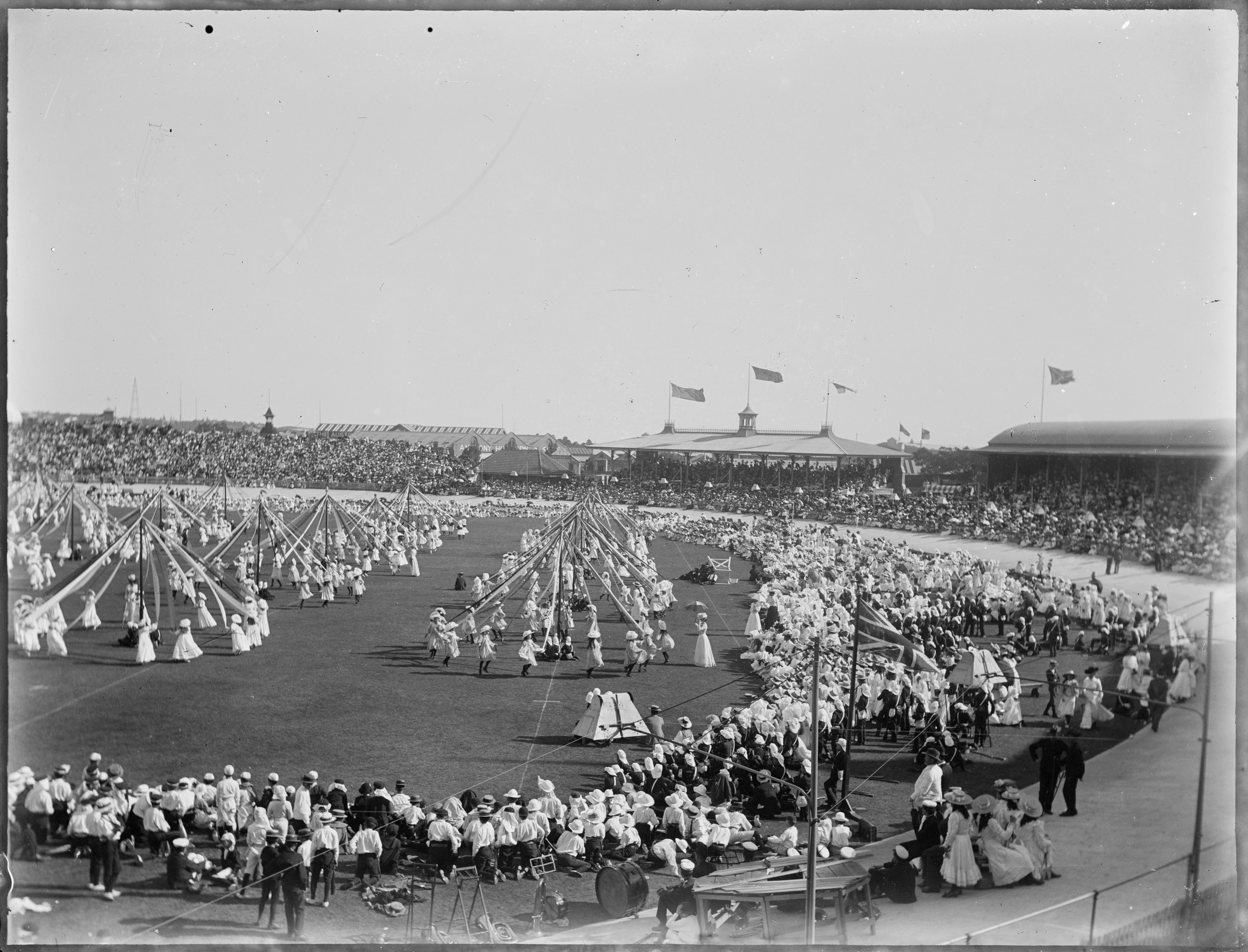
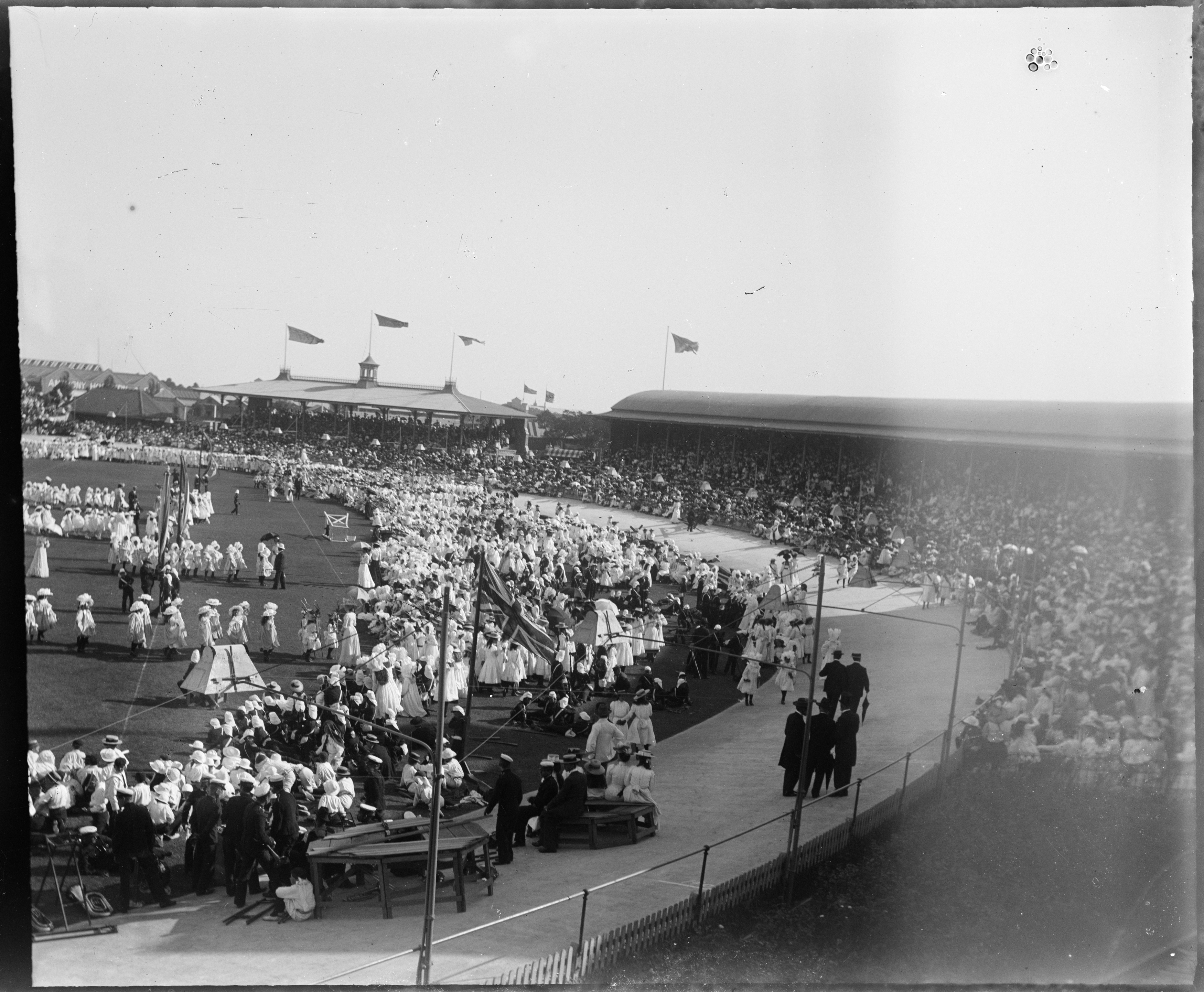
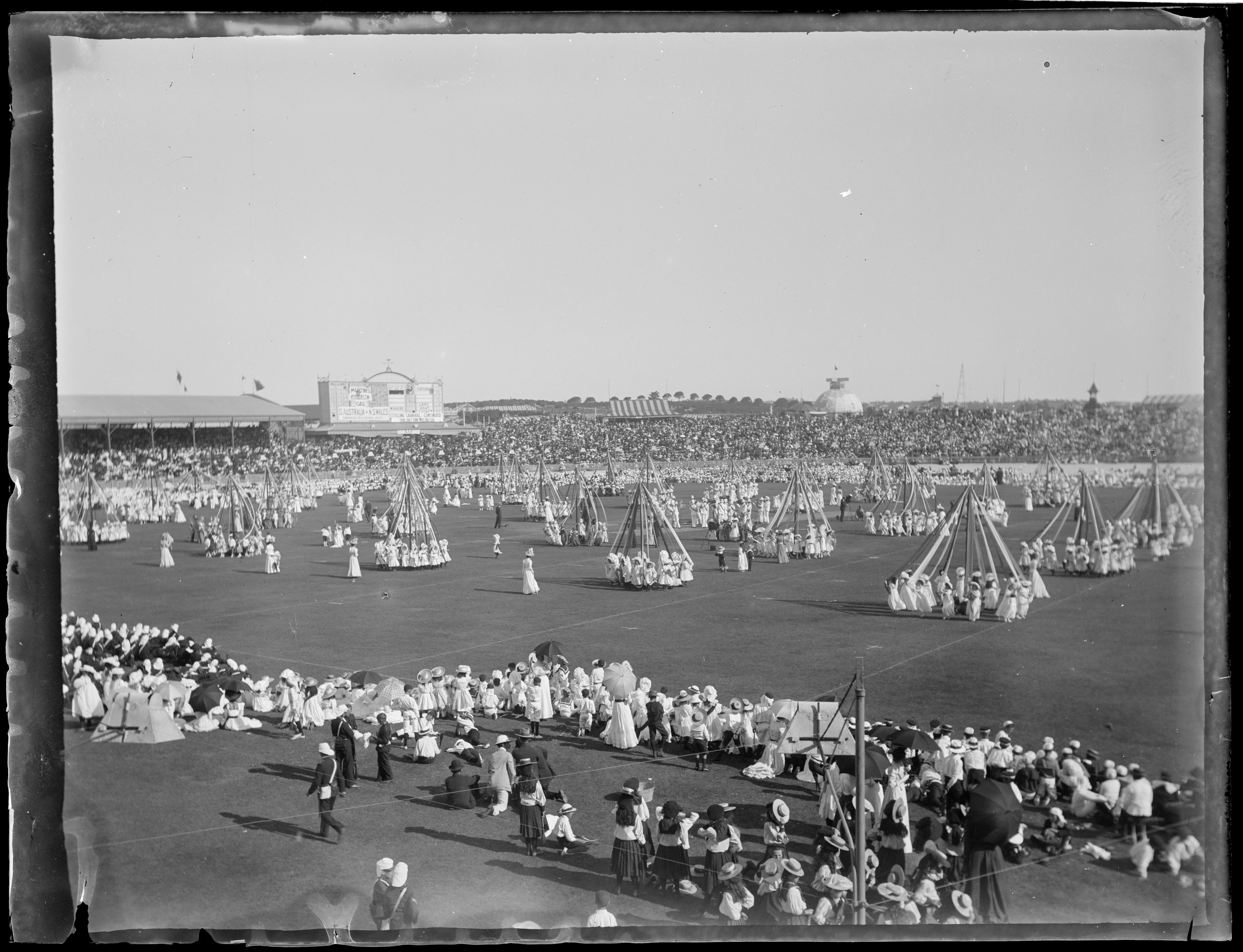
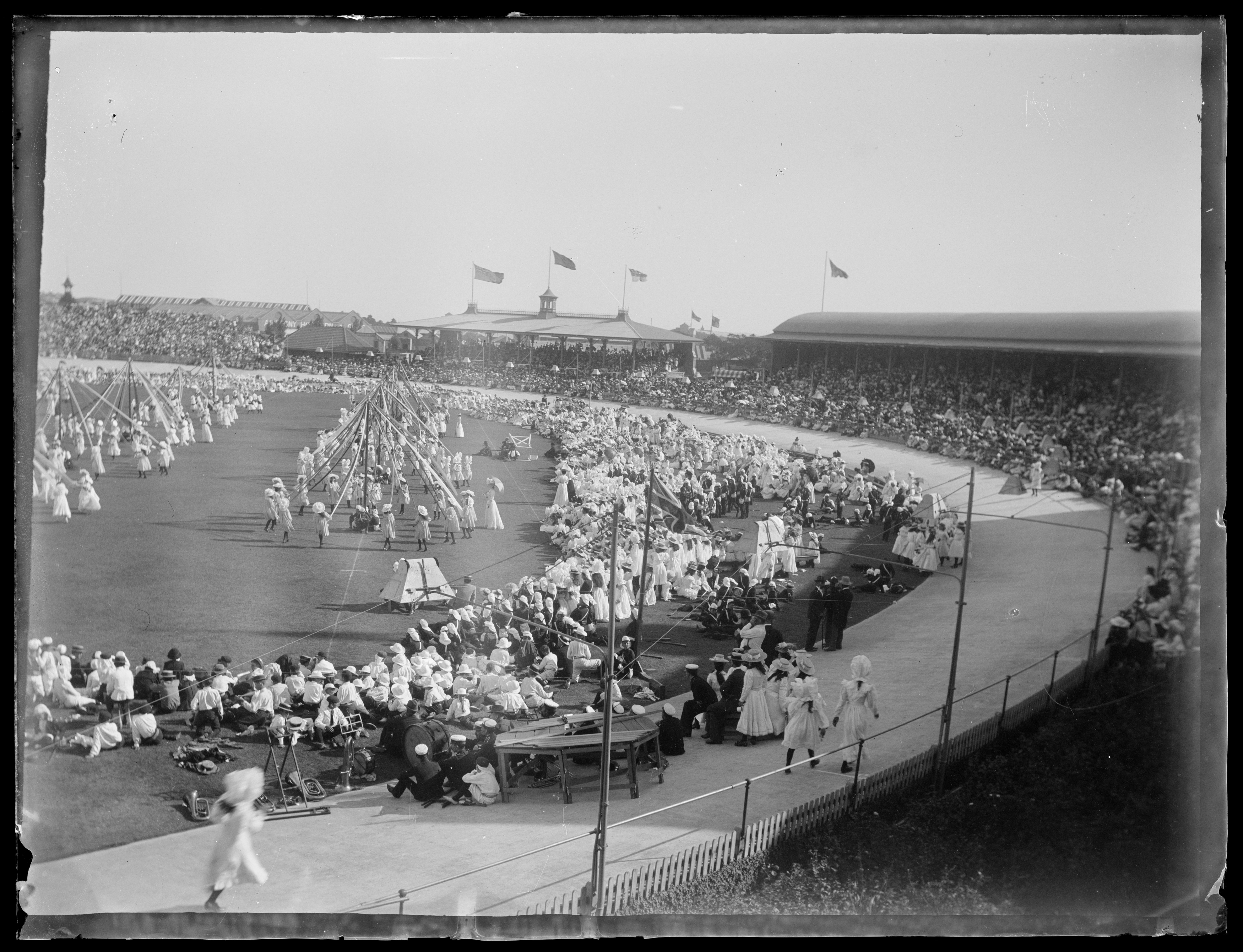
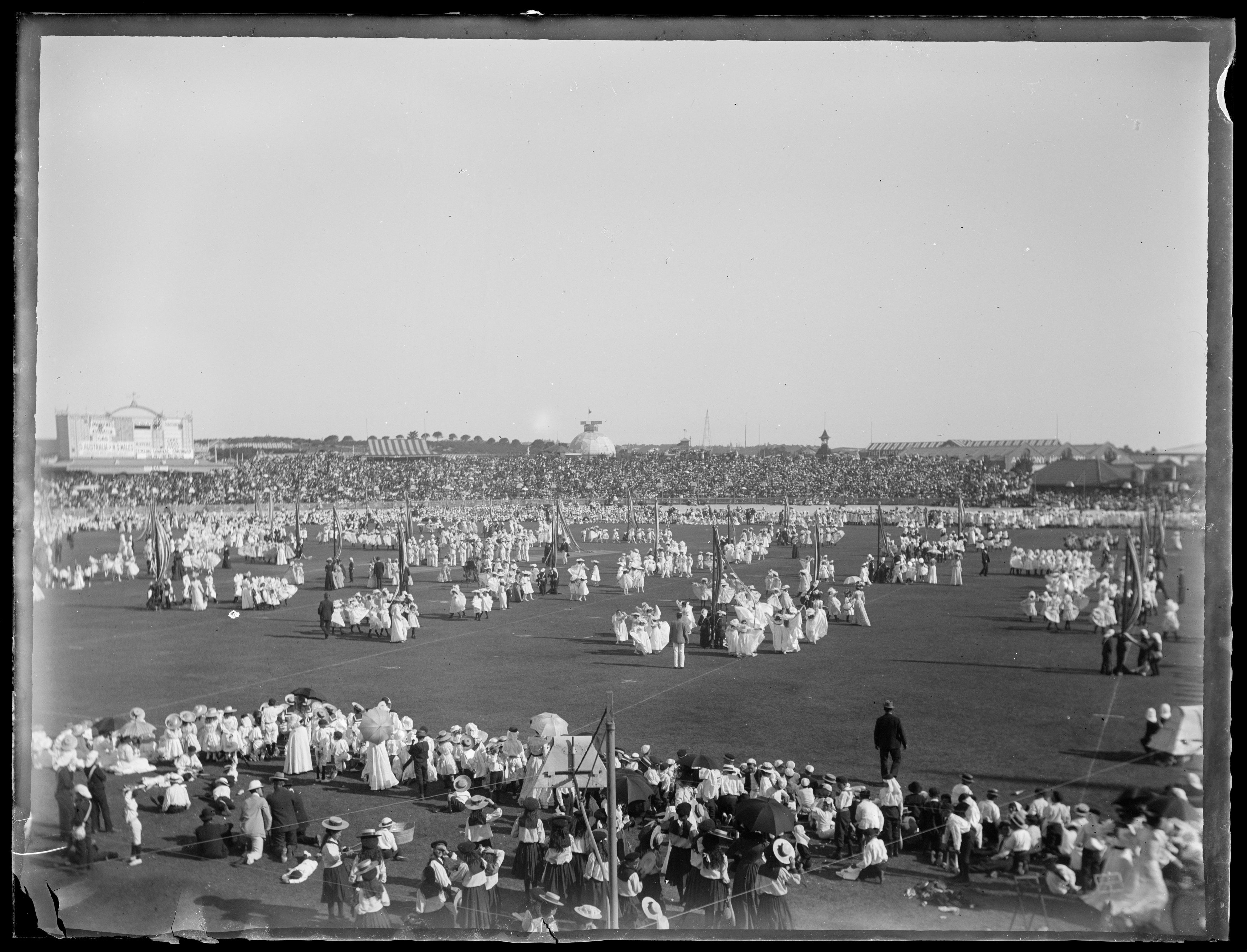
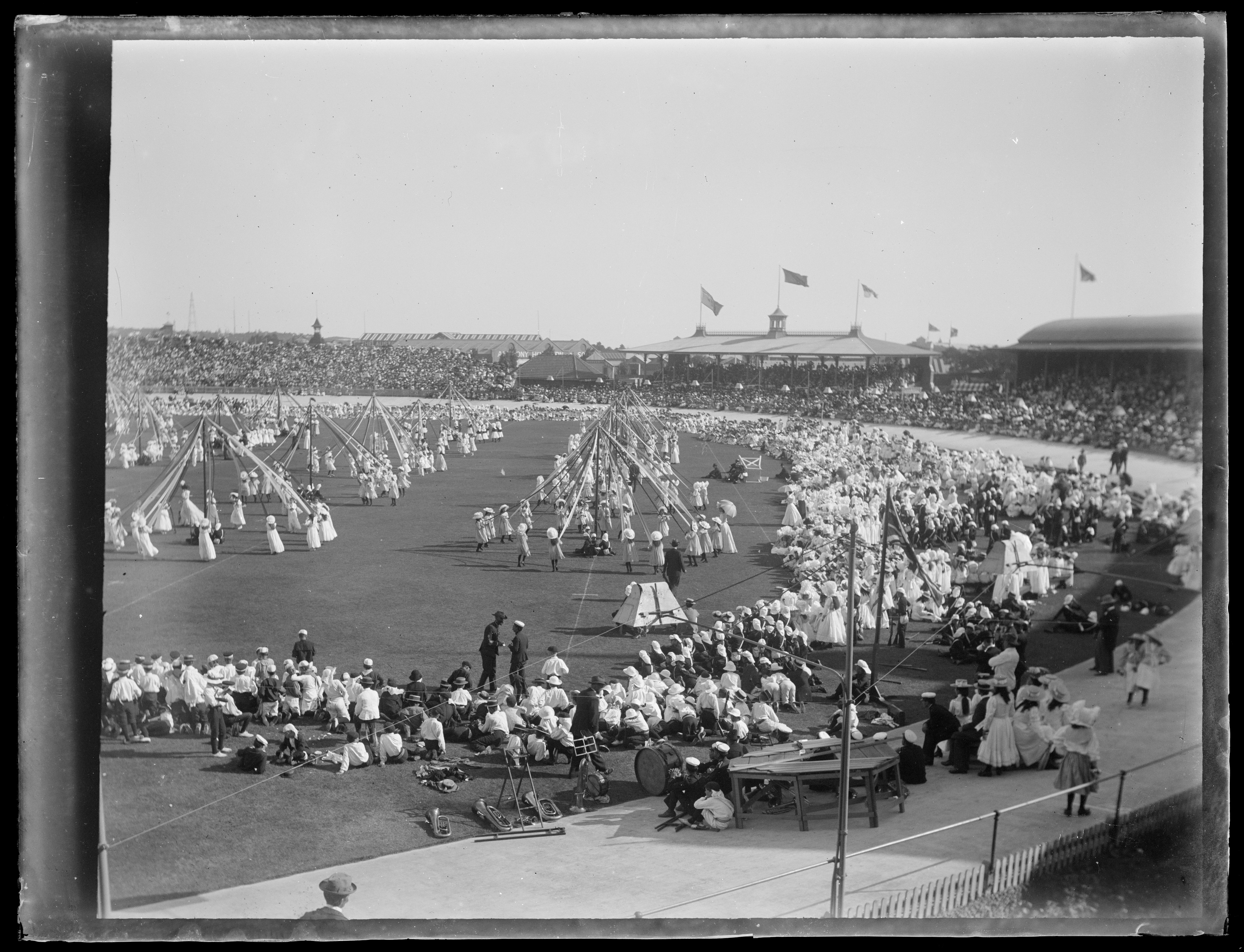
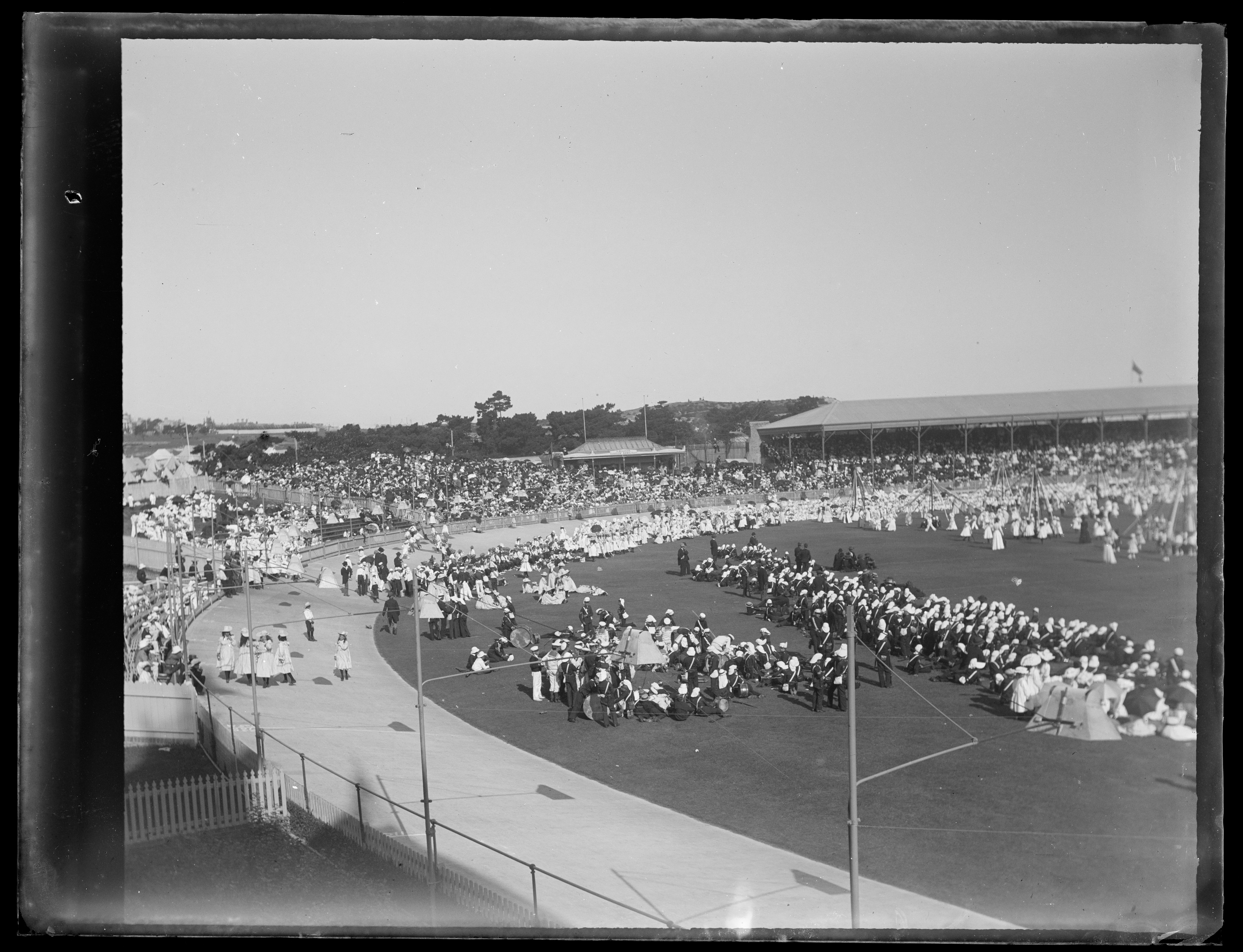
Images No.: c071170014, c071170015 from Box 03, Glass negatives including images of the Sydney and Blue Mountains regions, ca 1890-1910, by William Joseph Macpherson, or his brother, Edward Hume Macpherson, who took a lot of photos for decades which appeared in newspapers and art periodicals, and Images No.: c071860045, c071860048, c071860049, c071860050 and c071860051 from 'Box 21: Glass negatives including views of New Zealand farms, Sydney Harbour, Narrabeen, and maypole dancing at the SCG (children's display 1901), ca. 1890-1910.' Presented by David William Macpherson, 2014, courtesy State Library of NSW.
The Sydney Mail and New South Wales Advertiser certainly published Macpherson photos in its January 12th, 1901 edition - the family were living at Mosman then so their youngsters may have been involved in the Federation of Australia celebrations - other images in the collection of the grand parades through the streets of Sydney as part of the Proclamation are also available. The above event was similar to another that happened later that year:
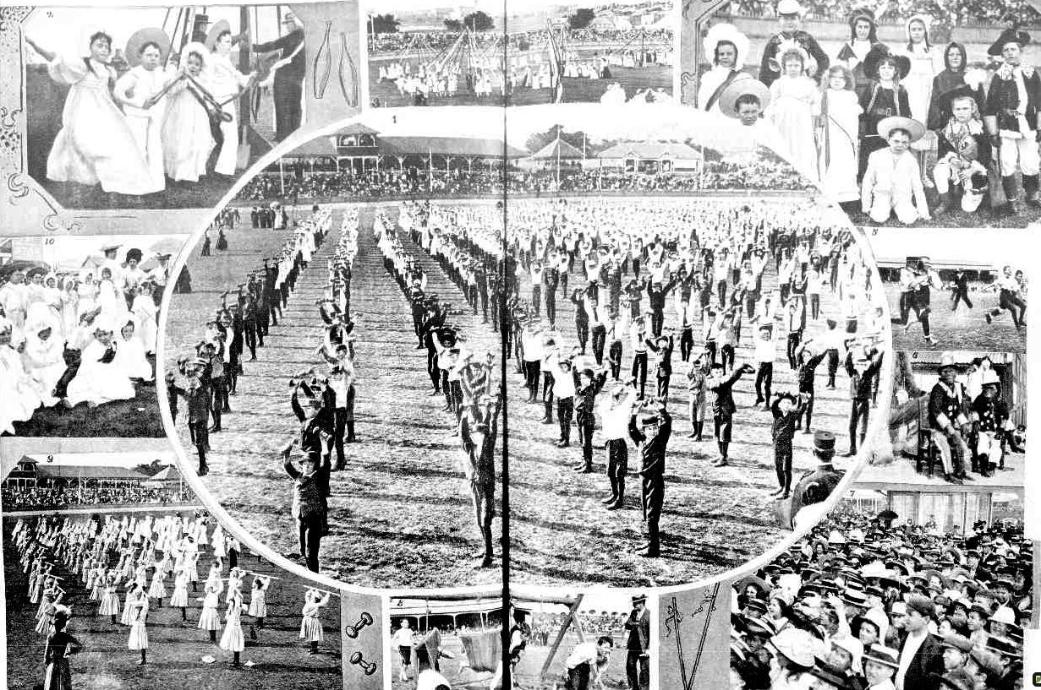
A few weeks after that display on January 3rd, 1901 a Festival for Children to mark the occasion took place at Manly on January 16th, 1901 for all the school children in the district from Manly to Pittwater, which, apart from students from Manly school, had largely left out those schools in Pittwater. The organisers had been planning the event since 1900 as well:
AT MANLY.
A meeting of the committee, which was recently instituted to carry into effect the suggestions for celebrating the Inauguration of the Commonwealth was held at the council-chambers, Manly, on Tuesday evening. The Mayor (Alderman W. H. Fletcher) occupied the chair. There were also present Aldermen Passau, Carroll, Quirk, and Messrs. Mannell, Douglass, C. A. Laurence, Hannam, Haylock, and D S Ogilvy. The following names were added to the committee Lieutenant-Colonel Strong, Captain Kay, Messrs. Haylock, F. Hunt, and Holmes. It was decided to give the children of Manly and district a treat on the park, with illuminations at night, on Wednesday, January 16, 1901, also to present to each child an appropriate medal to celebrate the event. The programme of sports was left left in the hands of Lieutenant-Colonel Strong and Messrs. Mannell and Macmanamey, whilst Messrs. Passau and Hannam were deputed to arrange for the medals. It was also decided to erect a bandstand on one of the Manly reserves, and to make a parade on the north side of North Harbour, to be called the Commonwealth Parade. AT MANLY. (1900, December 13). The Sydney Morning Herald (NSW : 1842 - 1954), p. 7. Retrieved from http://nla.gov.au/nla.news-article14353030
NB: there is also a Federation Point at Manly, just off the Commonwealth Parade – near the Manly Art Gallery and Museum.
COMMONWEALTH CELEBRATIONS AT MANLY.
A meeting of the Manly committee of the Commonwealth celebrations was held on Thursday evening under the presidency of the Mayor (Alder-man W, H. Fletcher) Final arrangements were made for entertaining the children on Manly Park on Wednesday, January 16th. It was announced that the Government Architect had lent to the committee the whole of the Venetian masts, and flags and decorations which adorned Martin-place during celebration week. These will be placed round the park oval. The children will assemble at the Public School on the fete day in the morning and are there to be marshalled for the procession to the park where each, on production of a ticket, will receive a medal and a bag containing refreshments. Then sports will ensue, and will occupy the whole afternoon, the winners and placed competitors in each event being entitled to prizes, which will be presented when suitably inscribed at a later date. Bands of music will enliven the scene. Twelve hundred children are expected to take part. COMMONWEALTH CELEBRATIONS AT MANLY. (1901, January 12). The Sydney Morning Herald (NSW : 1842 - 1954), p. 9. Retrieved from http://nla.gov.au/nla.news-article14370171
On February 21st 1900 Newport school officially became 'Newport Public School', meaning there were more children in attendance. Local records indicate there were over 100 people living in Newport by now and 20 homes. Their teacher then was a Mrs. Norris, who had come to the school in 1897 and would be there until transferred in 1902. Although the school at Newport is not listed among those included, and 'neighbouring districts' hopefully meant some of the youngsters were there - those under Samuel Morrison at Bay View, that school on the Pittwater estuary, certainly were, as weer those at Narrabeen.:
CELEBRATIONS AT MANLY, FESTIVAL FOR THE CHILDREN.
Manly will to-day celebrate the inauguration of the Commonwealth by a children's festival, which is to be held in the local park. The children will be drawn from Manly, Narrabeen, Bay View, Brookvale, and neighboring districts, the only qualification required being that each child shall be a bona-fide resident. One of the attractions at the park, which has been gaily decked for the occasion, will be a programme of sports, consisting of some 18 events, and including competitions for girls as well as boys. Refreshments will be provided, and every child will be presented with a Commonwealth medal of special design. The arrangements are in the hands of an up-to-date committee, with Messrs. D. S. Ogilvy and E. W. Quirk as honorary secretaries. CELEBRATIONS AT MANLY. (1901, January 16). The Daily Telegraph (Sydney, NSW : 1883 - 1930), p. 7. Retrieved from http://nla.gov.au/nla.news-article240123366
CHILDREN’s COMMONWEALTH FESTIVAL AT MANLY PARK JANUARY 16 1901
LARGE and influential committee of Manly residents, headed by the Mayor (Alderman W. H. Fletcher), has for some time been perfecting arrangements for entertaining the children of Manly and district by way of commemorating the inauguration of the Commonwealth. The festival was held last week on Manly Park, and proved a success. The park had been specially decorated with flagpoles loaned by the Government Architect.
These with their banners, trophies, and lines of bunting gave the oval a very gay appearance. The children assembled on the flat in hundreds, and many were seated on the surrounding slopes. The majority of the children assembled at 11 a.m. at the Public school, where they wire marshalled by Mr. Mannell and his assistants, and were thence marched in procession, headed by the National Guild Baud, vii the Corso and Steyne to the park. Refreshments were handed out, after which the children were paraded, and each one received a bronze medal commemorative of the day. 1250 medals were given out, and still there remained some children who had to go away without a token.
During the afternoon a programme of sports was conducted, which occupied the remainder of the day, and the children returned home with happy memories of the day on Manly Park. Mr. Dugald Thomson, M.L.A., Miss Thomson, Alderman W. H. Fletcher (the Mayor), and Mrs. Fletcher officiated at the distribution of the medals, and the Mayor also handed over the prizes to the placed competitors in the several events. To Messrs. Mannell and Ogilvy credit is due for the carrying out of the programme of sports, and with them were associated as judges, starters, and referees the following gentlemen .-—Messrs. Passau, Hosking, Bonnor, Carroll, Hansam, Walker, Holmes, Douglas, Hadley, Lough, Hilliard, Strong, Morrison, M'Coy, Smith, Boasley, and Lawrence. The programme included the following events : — Flat race for boys and girls, hoop race, skipping race, handicap bicycle race, potato race for boys, cotton winding race for girls, Siamese race, the needle race for girls, sack race for boys, obstacle race.
.jpg?timestamp=1582933219548)
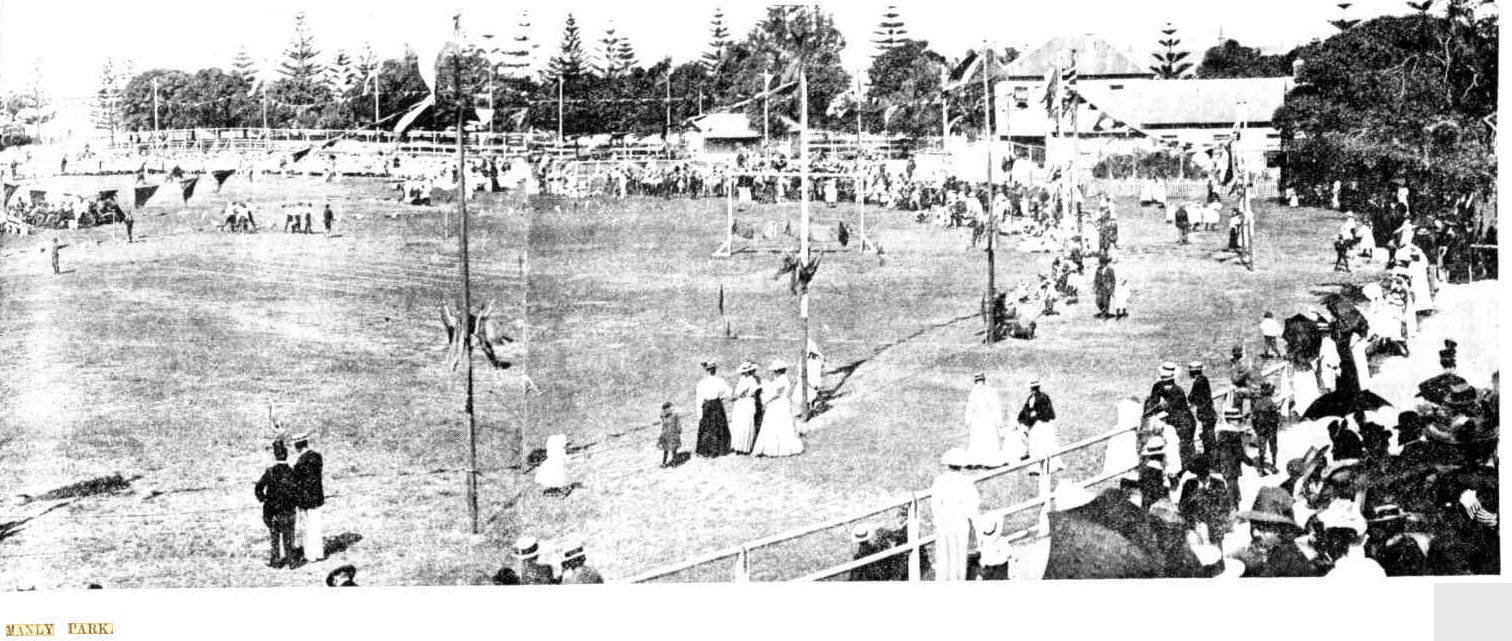
THE OVAL MANLY PARK.
.jpg?timestamp=1582933368129)
SOME OF THE PRIZE WINNERS.
.jpg?timestamp=1582933401508)
VIEW REAR PAVILION.
.jpg?timestamp=1582933428449)
THE DRAMA OF PUNCH AND JUDY ATTRACTED A LARGE AUDIENCE.
CHILDREN'S COMMONWEALTH FESTIVAL AT MANLY, JAN. 16. (1901, January 26). The Sydney Mail and New South Wales Advertiser (NSW : 1871 - 1912), p. 220. Retrieved from http://nla.gov.au/nla.news-article165294827
Another report on the day:
Festival at Manly.
A large committee of Manly residents, headed by the Mayor (Alderman W. H. Fletcher), has for some time been perfecting arrangements for entertaining the children of Manly and district by commemorating the inauguration of the Commonwealth. The festival was held on Wednesday, January 16, in Manly Park, and proved a success. The park had been specially decorated with flagpoles loaned by the Government Architect. These with their banners, trophies, and lines of bunting gave the oval a gay appearance. The children assembled on the flat in great numbers and many were seated on the surrounding slopes.
The majority assembled at 11 o'clock at the Public school, where they were marshalled by Mr. Mannell and his assistants, and were thence marched in procession, headed by the National Guard Band, via the Corso and Steyne to the park. Refreshments were handed out, after which the children were paraded, and each one received a bronze medal commemorative of the day. 1250 medals were given out.
During the afternoon a programme of sports was conducted. Mr. Dugald Thomson, M.L.A., Miss Thomson, Alderman W. H. Fletcher (the Mayor), and Mrs Fletcher officiated at the distribution of the medals, and the Mayor also handed over the prizes to the placed competitors in the several events. With Messrs. Mannell and Ogilvy were associated as judges, starters, and referees the following gentlemen:—Messrs. Passau, Hosking, Bonnor, Carroll, Hannam, Walker, Holmes, Douglas, Hadly, Lough, Hilliard, Strong, Morrison, M'Coy, Smith. Boasley and Laurence. The programme included the following events :—Flat race for boys and girls, hoop race, skipping race, handicap bicycle race, potato race for boys, cotton winding race for girls, Siamese race, thread the needle race for girls, sack race for boys, obstacle race. Festival at Manly. (1901, January 22). The Mosman Mail (NSW : 1898 - 1906), p. 4. Retrieved from http://nla.gov.au/nla.news-article247004050
As can be read above, a lot of medals were handed out, showing how many school children were already studying in the area. However, they didn't have enough and one group missed out on the day. A little about the Good Samaritan Industrial School, Manly:
Good Samaritan Industrial School, Manly.
On Thursday evening, March 23, there will be a moonlight harbour excursion in aid of the funds of the Good Samaritan Industrial School, Manly. The steamer Brighton has been chartered, and will leave Circular Quay at-7.45 p.m., and Manly at 8.15 p.m., proceeding afterwards on a grand trip round the harbour. It will return about 10 p.m. There will be a band and a concert on board. As the tickets are only 1s we expect to see a large number availing themselves of the outing and aiding a most deserving object. Good Samaritan Industrial School, Manly. (1899, March 25). The Catholic Press (Sydney, NSW : 1895 - 1942), p. 14. Retrieved from http://nla.gov.au/nla.news-article104662946
GOOD SAMARITAN INDUSTRIAL SCHOOL, MANLY.
The Cardinal-Archbishop conferred the Sacrament of Confirmation on twenty-one children of this institution on Thursday. On his arrival, accompanied by one of the staff of St. Patrick's College, the children, to the number of one hundred, who had been drawn up to receive him, knelt down to receive his blessing. His Eminence proceeded to the church, where he examined the candidates. The children's intelligent answering reflected great credit on themselves and their devoted teachers, the Sisters of the Good Samaritan. The solemn function was brought to a close by Benediction of the Most Holy Sacrament. The Cardinal was specially pleased with the singing of the children. The artistic decoration of the altar, too, was much admired. Rev. Mother and Sisters, with the aid of a kind friend, provided the children with a little feast. GOOD SAMARITAN INDUSTRIAL SCHOOL, MANLY. (1897, September 11). Freeman's Journal (Sydney, NSW : 1850 - 1932), p. 16. Retrieved from http://nla.gov.au/nla.news-article115468794
WE BEGIN REVIEW OF THE YEAR 1898.
We notice that in January, of that year the Good Samaritan Industrial School, at Manly, entertained a number of Catholic and Protestant friends who had helped at the annual fete, which realised over £304. The presentation of the cheque was made at a ceremony presided over by the Mayor of Manly, Alderman Passau. The staff of St. Patrick's College present included Rev. H. McDermott, Rev. J. Brosnan, Rev. P. Bowling, and Rev. T. Hayden, now parish priest and Monsignor of the Sacred Heart Parish, Darlinghurst. Rev. Mother M. Cecilia was in charge of the orphanage, and, on her behalf, a return thanks was given by Dr. Sydney Watkins. The cheque was handed over to the Rev. Mother by Mrs. Douglas, secretary of the Ladles' Committee. Many years ago the Good Samaritan Industrial Home was transferred to Mater Dei, Narellan, the picturesque Home which shortly will hold its annual reunion. LOOKING Backwards (1936, September 17). Catholic Freeman's Journal (Sydney, NSW : 1932 - 1942), p. 14. Retrieved from http://nla.gov.au/nla.news-article146392115
The Grand Garden Fete at Manly
The Week's Attraction. THE OPENING CEREMONY. ADDRESS BY THE COADJUTOR ARCHBISHOP.
One of the social events of the year is the fete in aid of the Manly Industrial Home for orphan girls, conducted by the Sisters of the Good -Samaritan, which is hold in the grounds of the Home at Manly, and was opened on Tuesday afternoon by his Grace the Coadjutor- Archbishop (Most Rev. Dr. Kelly). There was a good attendance, fully 300 ladies and gentlemen being present. ....
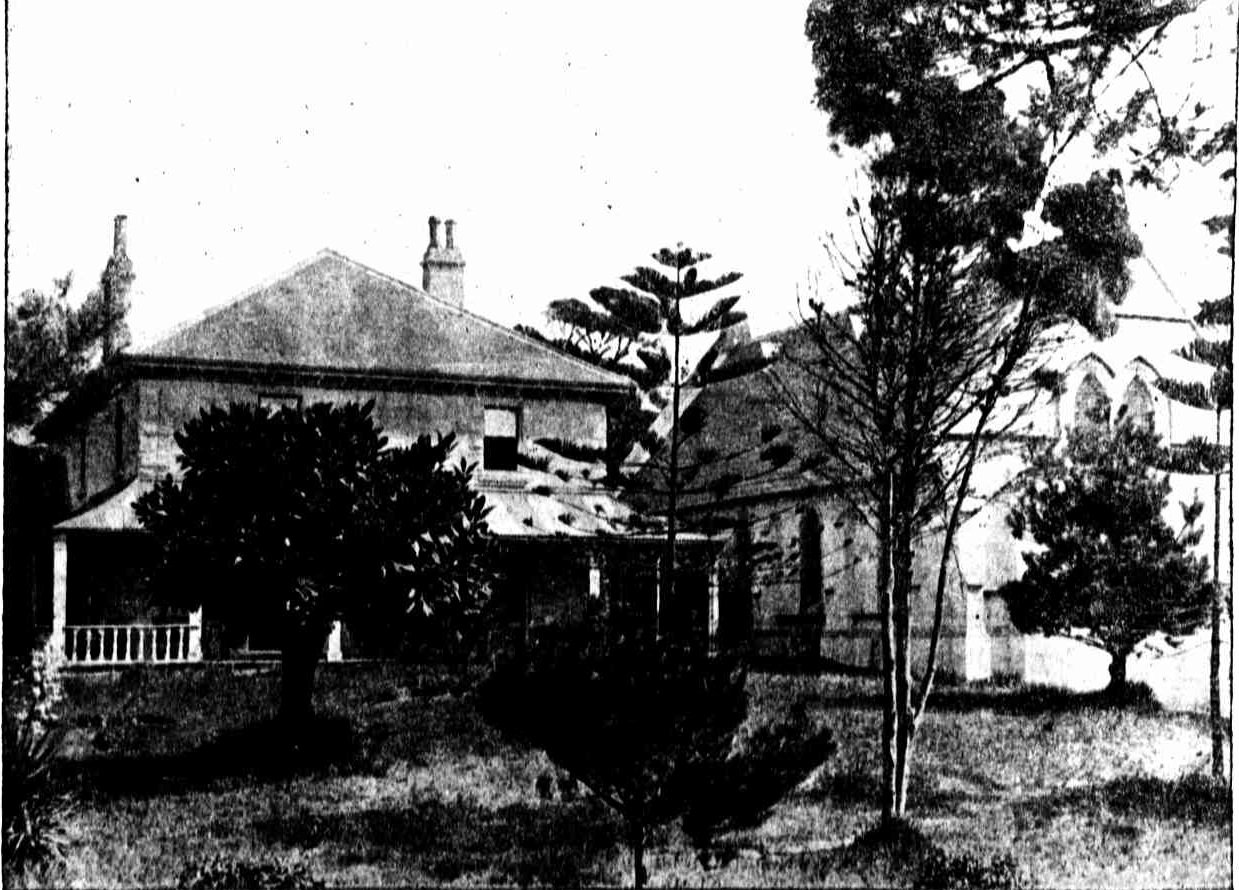
Where the Fete is Being Held : Good Samaritan Industrial School, Manly.
The Grand Garden Fete at Manly (1903, October 22). The Catholic Press (Sydney, NSW : 1895 - 1942), p. 22. Retrieved from http://nla.gov.au/nla.news-article104895327
David Skene Ogilvy and Mayor Ellison Wentworth Quirk arranged for more medals to be pressed and these were presented to the children who had missed out in January - the Powerhouse Museum (MAAS) hold two medals, donated by the Australian Museum, of this Children's Fete at Manly - one of Bronze and one of Copper, of which it would seem., from the reports above, the bronze was handed out on the day, and running out of those, a copper version was pressed and handed out later to the children of the above training facility:
MANLY CELEBRATIONS COMMITTEE.
The above committee resolved at its formation some time ago to endeavour to carry out a programme of events commemorative of the Common-wealth, and at its meeting on Friday it was reported that two out of four of its projects had been successfully accomplished. The Mayor of Manly (Alderman E. W. Quirk) was in the chair, and together with his co-secretary (Mr. D. S. Ogilvy) there were present Messrs. C. A. Laurence, F. C. Passau, Owen Carroll, V. W. Mannell, W. Kay, W. J. Douglass, and T. C. Haylock. Mr. Ogilvy brought up a report relating to the decoration of the Corso, the cost of which was mainly contributed by the tradespeople on that thoroughfare. Reference was also made to the successful children's fete held recently in Manly Park, the accounts for which, amounting to about £58, were passed for payment. The balance of cash in bond was entrusted to the joint secretaries for deposit in the Savings Bank, where it is to form the nucleus of a fund wherewith the committee hopes eventually to carry out the remaining items of its programme, namely, the erection of a bandstand and the formation of a marine parade to be known as Commonwealth Parade. MANLY CELEBRATIONS COMMITTEE. (1901, March 4). The Sydney Morning Herald (NSW : 1842 - 1954), p. 5. Retrieved from http://nla.gov.au/nla.news-article14364507
MANLY COMMONWEALTH MEDALS.
The children of the Good Samaritan Industrial School participated with many of the youth of Manly and district in the fete held on Celebration Day on Manly Park, but there happened to be a shortage of medals, and the Good Samaritans were temporarily left without such emblems. The shortage has since been made good by the local celebrations committee. On Wednesday evening the Mayor (Alderman E. W. Quirk) together with his co-secretary, Mr. D S. Ogilvy, accompanied by Alderman F. C. Passau, took down to the institution the necessary number of medals, and distributed them to the eager recipients. MANLY COMMONWEALTH MEDALS. (1901, March 8). The Sydney Morning Herald (NSW : 1842 - 1954), p. 3. Retrieved from http://nla.gov.au/nla.news-article14344473
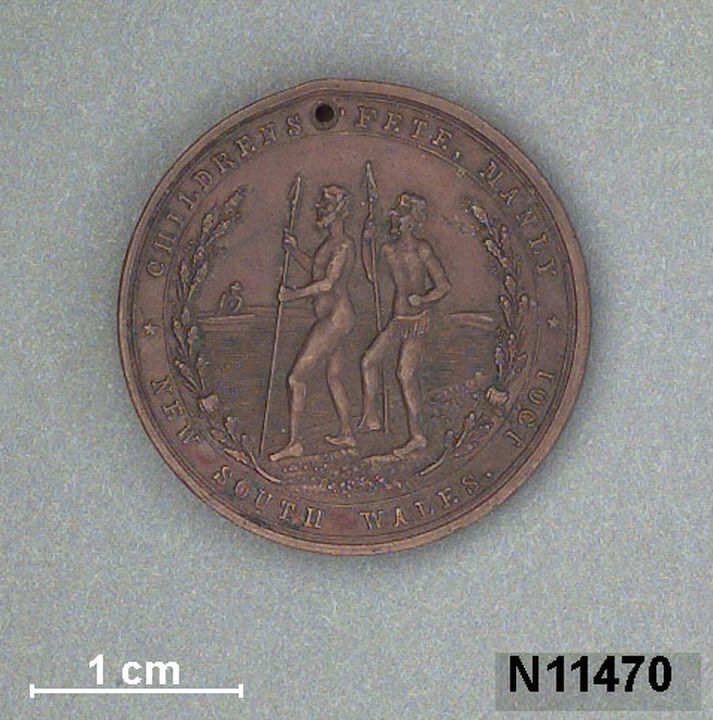
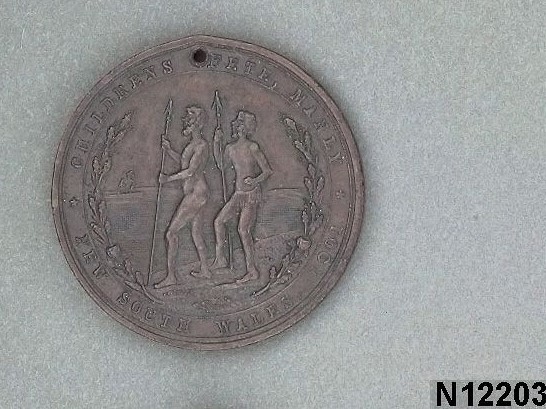
Medal, Australia: NSW. Federation 1901, bronze, Children's Fete, Manly (CI). Medal, Australia: NSW. Federation 1901, copper, Children's Fete, Manly (CI).
The Years of Expansion: Towards Federation and a Commonwealth Coinage: Throughout the 1880's there was growing recognition that some form of Federation was necessary for the security and welfare of the Australian Colonies, in the near future. A report on the necessity for the military forces of the various Colonies to be under unified command provided the Premier of New South Wales, Sir Henry Parkes, with the opportunity to deliver a notable address on Federation at Tenterfield, on 24th October, 1889. From this date the Federation movement gained momentum, aided by local Federation Associations which played a significant role in promoting public interest; and by March, 1898 a Federal Constitution had been agreed upon between the Colonies.
At noon on 1st January, 1901 Lord Hopetoun read the Queen's Proclamation establishing the Commonwealth of Australia, to a vast audience in Centennial Park, Sydney. In succession he was sworn in as Governor-General, and James Barton as Prime Minister, of the new Commonwealth. The old dream of Federation had been achieved, and the former Colonies became States of the new nation. Some of the medals relating to this era are displayed. From Sydney Mint Museum label written by curator, Major HP (Pat) Boland, c1982. Source Credit Line Gift of Australian Museum, 1961 Acquisition Date 27 February 1961
The Manly Children's Festival to Celebrate Federation weren't the only 1901 Commemoration medals made, alike the earlier Trade Tokens, many businesses and even government themselves made medals. One example - there are still some for sale, ranging from $50.00 upwards:
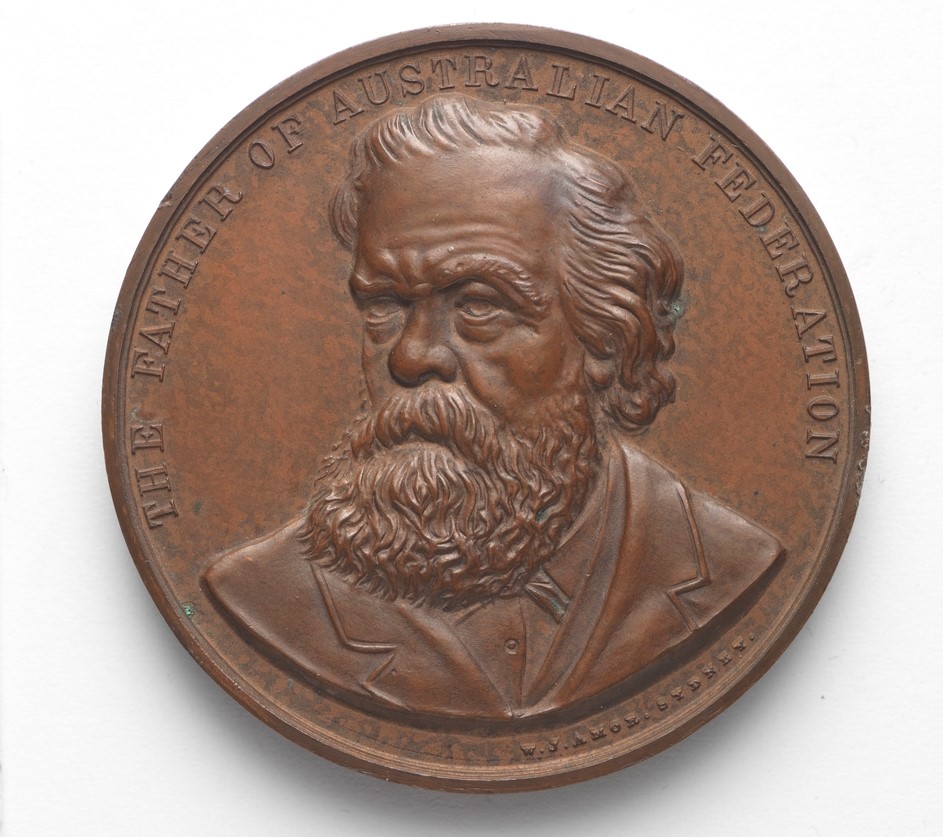
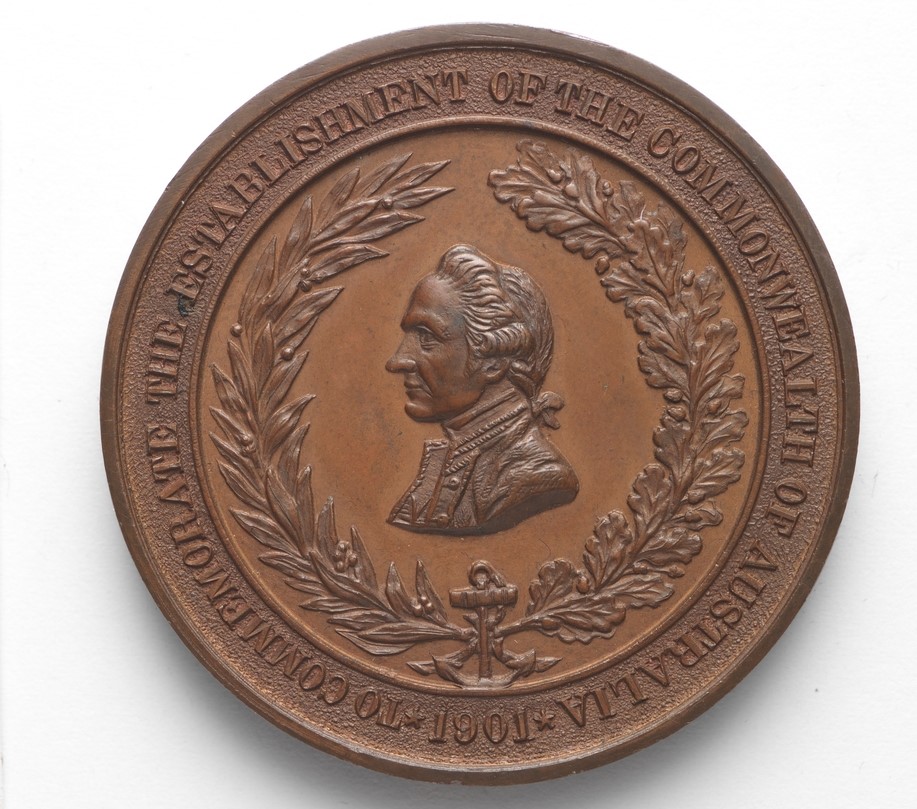
Medallion commemorating the establishment of the Commonwealth of Australia, 1901, featuring Henry Parkes, the Father of Federation 1879-1901 - Obverse of medallion features Sir Henry Parkes and legend 'The Father of Australian Federation' and name of issuing firm 'W.J. Amor Sydney' Reverse of bronze medallion features Captain James Cook and the legend 'To commemorate the establishment of the Commonwealth of Australia 1901'. Items; a9539001h and a9539002h courtesy Mitchell Library, State Library of New South Wales.
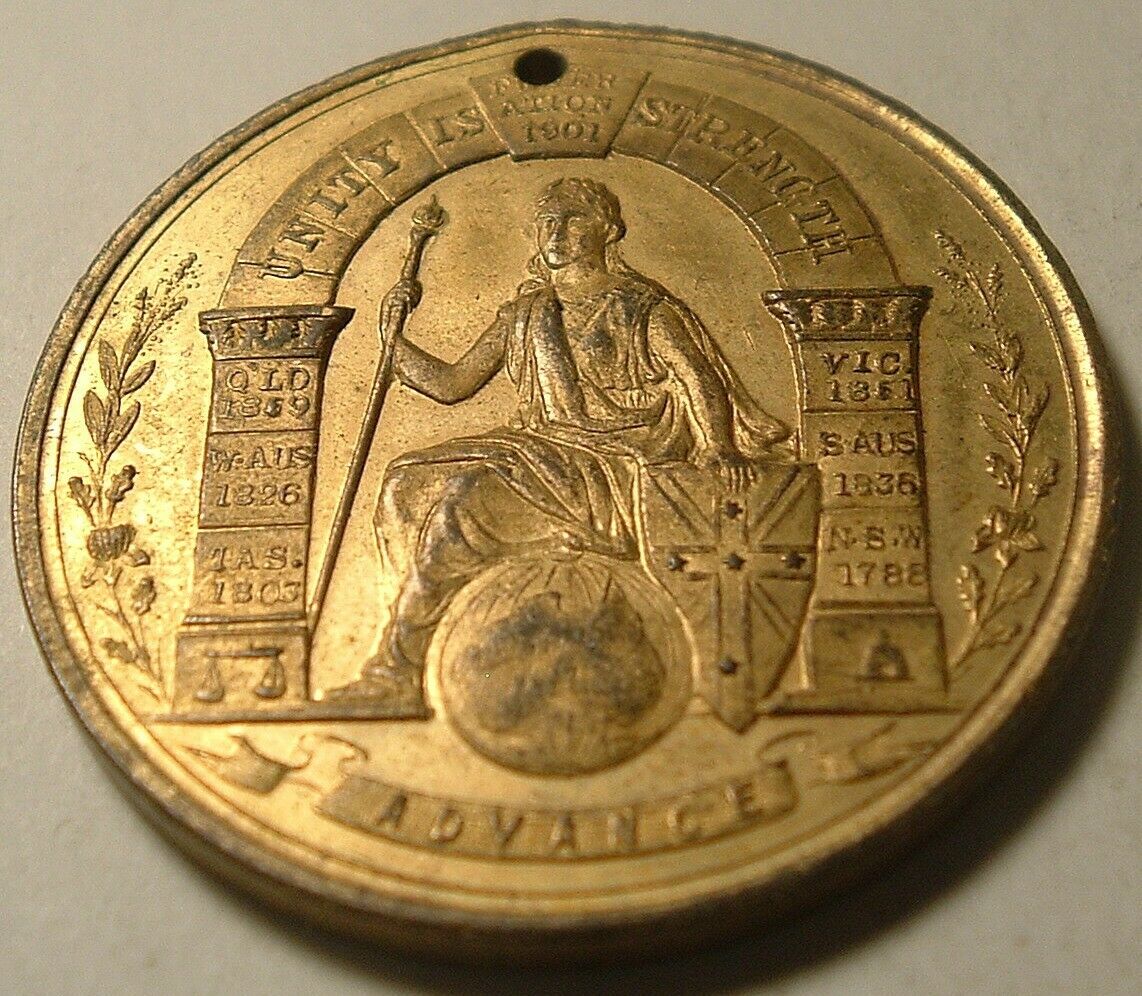
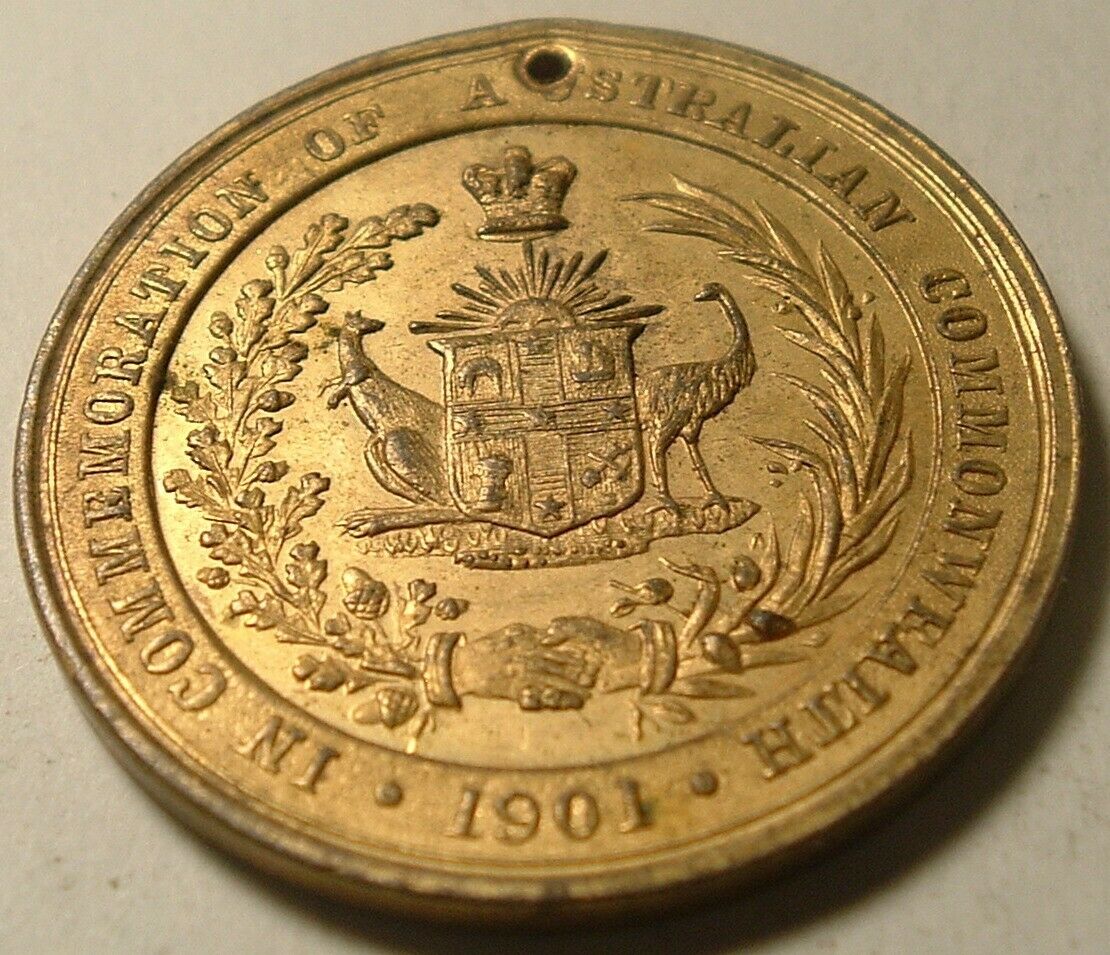
Medallion commemorating the establishment of the Commonwealth of Australia, 1901 and Obverse - currently for sale via E-Bay for 50 US Dollars.
Once again there are a few Pittwater connections here. The first comes through Warriewood's Cook Terrace. Cook Terrace may have been named for Salvation Army Ensign, later Captain Sidney Cook, a projectionist who travelled to present Salvation Army Films produced under the 'Limelight Department' of the Salvos, arguably one of the first to produce feature films in Australia.
The Limelight Department was one of the world's first film studios, beginning in 1898, operated by The Salvation Army in Melbourne, Australia. The Limelight Department produced evangelistic material for use by the Salvation Army, including lantern slides as early as 1891, as well as private and government contracts. In its 19 years of operation, the Limelight Department produced about 300 films of various lengths, making it one of largest film producers of its time.
The major innovation of the Limelight Department would come in 1899 when Booth and Perry began work on Soldiers of the Cross, arguably the first feature-length film.
The presentation contained fifteen ninety-second sections and two hundred lantern slides, and ran for nearly two and a half hours. While some Lumiere footage was used in the opening passion sequence of the film, the majority of the footage was filmed in Melbourne, either in the attic of 69 Bourke Street, on the tennis court of the Murrumbeena Girls Home, or in the pool at Richmond Baths.
The presentation itself focused of the lives and deaths of early Christian martyrs and cost £550 to produce. The scenes were considered extremely violent for their time, including such images as the stoning of Stephen, the burning of Polycarp and unnamed Christians being tortured, beheaded, killed by gladiators, drowned, or burned alive. The presentation included a cast of 150 Salvation Army officers who were stationed in Melbourne at the time. The many death scenes took their toll, with the cast suffering various injuries, including scorched hair and eyebrows from the fires used. The presentation premiered on 13 September 1901, at the Melbourne Town Hall, to a crowd somewhere between three and four thousand. One reviewer spoke of how the death scenes caused several women to faint in the aisles.
Soldiers of the Cross fortified the Limelight Department as a major player in the early film industry. However, Soldiers of the Cross would be dwarfed by Inauguration of the Australian Commonwealth, when the Limelight Department was commissioned to film the 1901 Federation of Australia. It was the hope of the New South Wales government that the film would prove an imperishable record of the event, though little of the footage still exists. Perry set up five cameras at various point of the procession route and had to use a fire carriage to move quickly from one camera to the next.
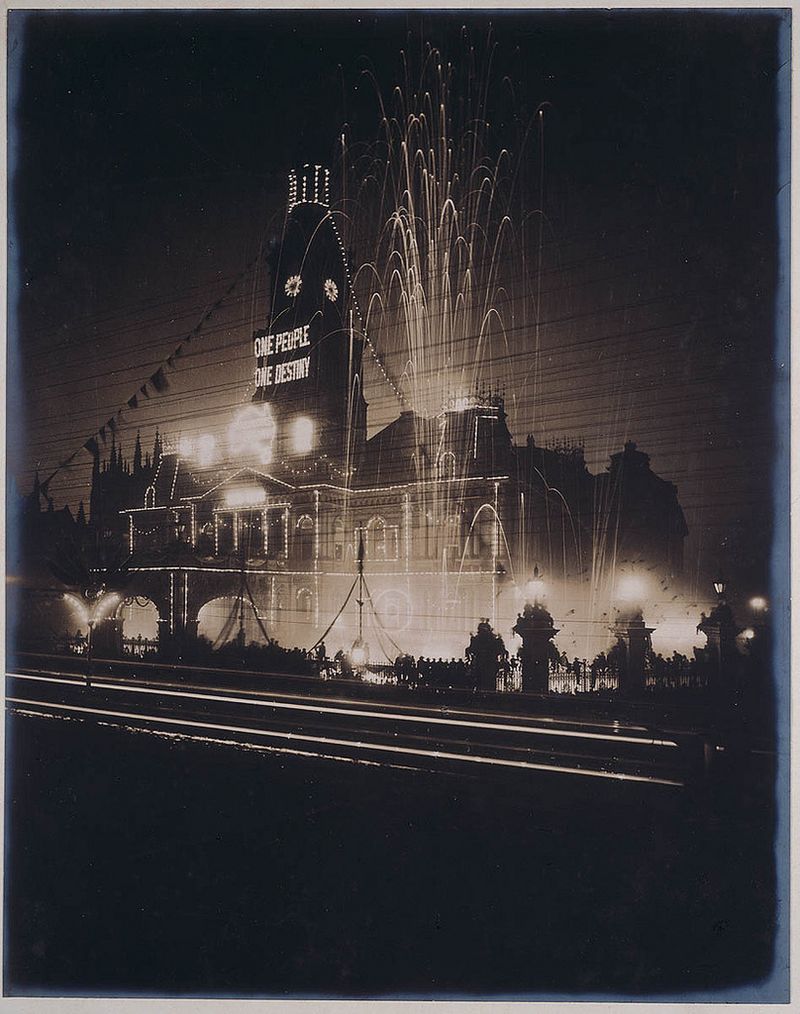
The Sydney Town Hall illuminated in celebratory lights and fireworks marking the Inauguration of the Commonwealth of Australia, 1901. The sign reads One people, one destiny. photo by W. A. Gullick - courtesy State Library of New South Wales
Later that same year the Royal visit of the Duke and Duchess of Cornwall and York, to open the first ever parliament in the Exhibition buildings in Melbourne. The Commonwealth Parliament was opened on May 9th 1901 in Melbourne, Victoria by Prince George, Duke of Cornwall and York, later King George V. The only building in Melbourne large enough to house the 14,000 guests was the Royal Exhibition Building. Thereafter, from 1901 to 1927, the Parliament met in Parliament House, Melbourne, which it borrowed from the Parliament of Victoria (which sat in the Royal Exhibition Building). On 9 May 1927 Parliament moved to the new national capital at Canberra, where it met in what is now called Old Parliament House. Intended to be temporary, this building in fact housed the Parliament for more than 60 years. The new and permanent Parliament House was opened on 9 May 1988 by Queen Elizabeth II.
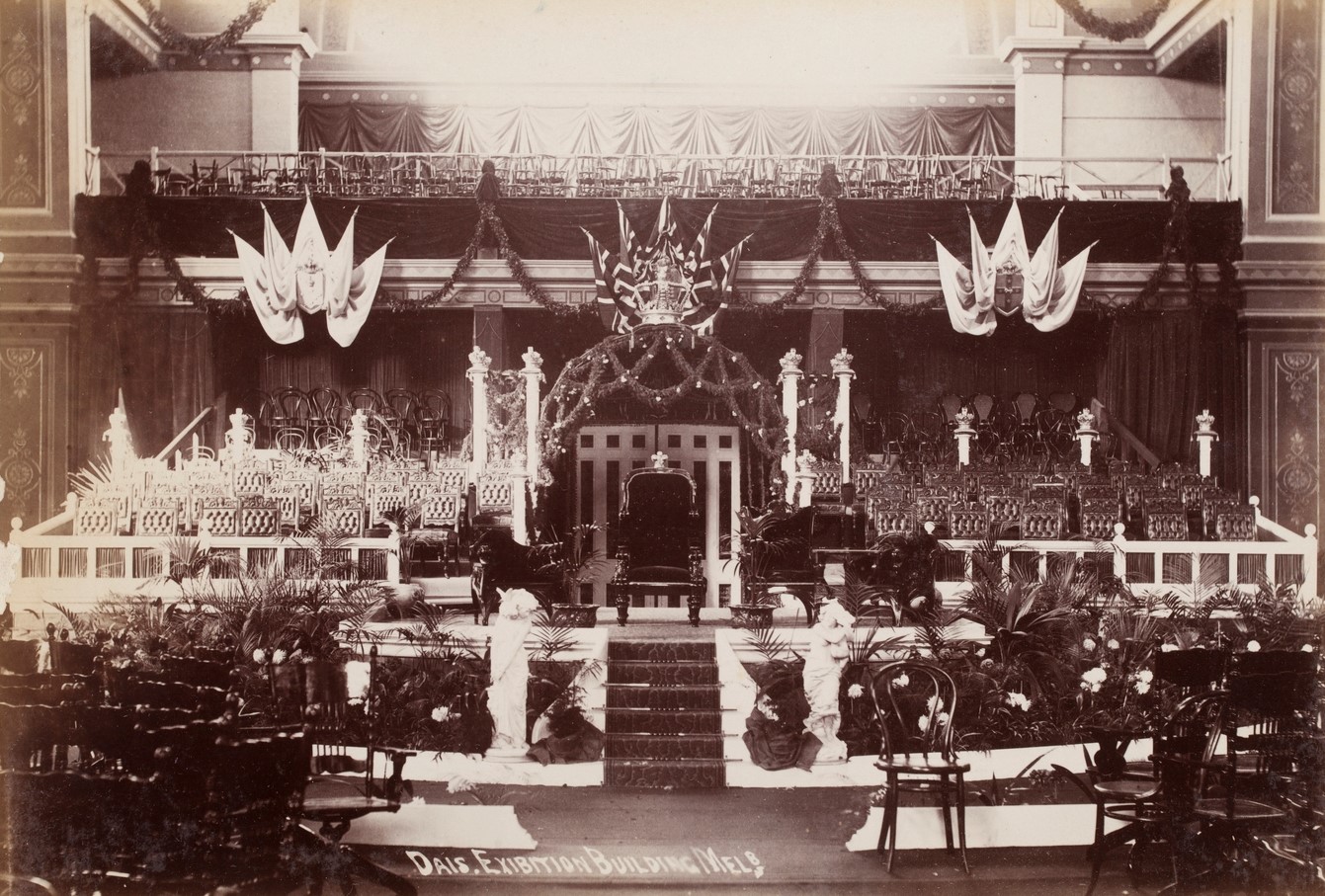
From Album of photographs relating to public celebrations of Australia's federation on 1st January 1901. Item: c004960113h, courtesy State Library of NSW - whole Album available online at HERE
Yet again another Commemorative Medal was struck to mark the occasion:
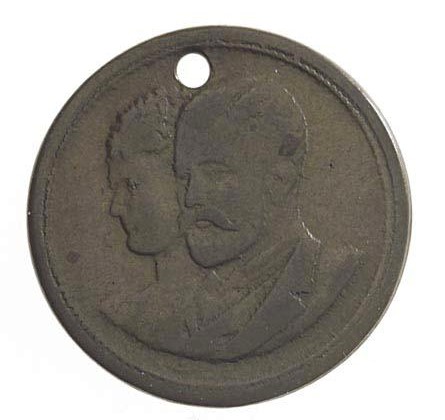
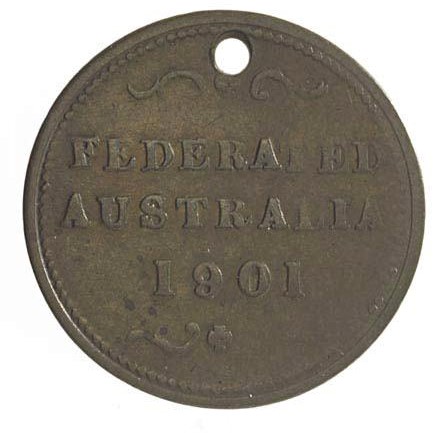
Medal - Australian Commonwealth,1901 AD Photographer: Jon Augier. Source: Museums Victoria. Copyright Museums Victoria / CC BY (Licensed as Attribution 4.0 International)
Medal - Federation of Australian Commonwealth & Royal Visit of Duke & Duchess of York, Australia, 1901. Summary - Medal issued to commemorate the establishment of the Commonwealth of Australia in 1901. It includes an image of Duke and Duchess of York, who visited in May 1901 to open the first Commonwealth Parliament. Their tour was one of the most lavish undertaken by the monarchy. An Orient steamship liner had to be chartered for the voyage as no royal yacht could span the required distances between coaling ports. The Daily Telegraph's 'London correspondent' reported that the 'The tour of the Duke and Duchess of York is likely to cost the British ratepayer a cool quarter of a million...' The royal visitors were received with great enthusiasm. Obverse Description- Conjoined busts of Duke and Duchess of York, Reverse Description: FEDERATED / AUSTRALIA / 1901
The Royal couple then headed north to Queensland and then to New South Wales where a second connection to Pittwater is seen in the Royal couple spending the Duchesses birthday in the Cowan Creek and along the Hawkesbury River:
The Royal Visit-The Duke and Duchess in Sydney. A Royal and Loyal Welcome.
(SEE ILLUSTRATIONS ON" PAGES 22, 23, AND 38.)
HALF-HOUR AT NEWCASTLE. ENTHUSIASTIC RECEPTION.
NEWCASTLE, Saturday Afternoon. Their Royal Highnesses the Duke and Duchess of Cornwall and York at noon to-day paid their promised visit to Newcastle. They received the loyal and hearty welcome of the residents, drove through the city, and left again by train for the Hawkesbury. The half-hour's Royal patronage and presence in the city, though short, was long enough to convince the Royal visitors of the unbounded loyalty of the populace.
The presence of the Governor-General and the State Governor has given rise to a claim by the Newcastle people that to-day marked the official entry Into New South Wales of the Duke and Duchess, and this idea is causing the residents no little gratification. The visit has certainly given unbounded delight to all sections of the community, who have, with one accord, laid themselves out to commemorate the event in a fitting j manner by elaborate and costly decorations.
At Honeysuckle Point, where the Royal party alighted from the train, the decorations were charming. The otherwise bleak-looking Northern platform was turned into a veritable tropical garden by the introduction of botanical specimens of beauteous foliage, and in other respects the station was gorgeously dressed in various colors and pretty designs.
Shortly before the arrival of the Royal train, the Governor-General (Lord Hopetoun), with the Lieutenant-Governor (Sir F. M. Darley), the Hon. John See (State Premier), and j Mr. Critchett Walker (Principal Under-Secretary), reached Honeysuckle by rail from Sydney. Lord Hopetoun was heartily cheered. He inspected the carriages and other arrangements with the Mayor (Mr. W. J. Ellis), and expressed general satisfaction with everything.
On alighting from the train, their Royal Highnesses were met by the Governor-General and Lieutenant-Governor, and officially welcomed to Newcastle by the Mayor. The Duchess was presented with a bouquet by the Mayoress (Mrs. Ellis) on behalf of the ladies of the city and district. Both the Duke and Duchess expressed great pleasure with everything. Their Royal Highnesses were accompanied by Lady Mary Lygon; Lord Wenlock; Sir Arthur Bigge, Sir Donald Wallace, Lord Leighton, Dr. Manby, and Lieutetnant-Colonel Byron.
On leaving the gaily-dressed railway platform their Royal Highnesses were received with a Royal salute by the guard of honor, and the band of the 4th Infantry played the National Anthem. Amid the hearty cheers of the people the visitors proceeded to ascend an artistic dais, which had been erected in the station grounds, and. there listened to the congratulations tendered them, both the Duke and Duchess talking pleasantly to all around. The band then struck up the National Anthem, which was sung by about 1700 school children, all prettily attired, who had been provided with accommodation.
At the conclusion, amid hearty cheers, their Royal Highnesses entered the carriages provided, and, preceded by a body of Mounted Police, and escorted by the Newcastle Half-Squadron of Lancers, drove through the city. At a point near the Honeysuckle Post Office there was another assemblage of school children, consisting of 5000 children, drafted from all the schools of the district, who, as the Royal procession was passing, sang "Rule, Britannia," to the accompaniment of a band. The drive through the city was slow, and enabled the visitors to fully inspect the decorations.
At the Newcastle Railway Station there was another guard of honor, and the City Band at once struck up the National Anthem.
The following was the order of the procession: First carriage, their Royal Highnesses, second carriage, the Governor-General; third carriage, the State Lieutenant-Governor; fourth carriage, the State Premier, fifth carriage, Mayor and Mayoress.
After a few minutes' stay at the Newcastle Railway Station, which was occupied in chatting pleasantly, the Royal train steamed out, amid the heartiest cheering ever previously heard in Newcastle.
For a couple of hours business in the city was totally suspended, and it is asserted that never before has there been so many people in Newcastle at any one time as there were to-day. The city decorations were splendid, while the police and other arrangements were perfect. The balconies on the lane of procession were crowded, and all along the route the Royal visitors were heartily cheered. Both the Duke and Duchess bowed their acknowledgments as they drove past. Everything passed off without a hitch, and before leaving the Governor-General expressed his genuine pleasure at the way in which the arrangements had been carried out.
.jpg?timestamp=1582942797638)
Scene in Farm Cove, Sydney Harbor, at the Moment of Landing. (Photo. by G. A. Hills, 82 King-street.).-
.jpg?timestamp=1582942824090)
The Procession in Martin Place, Sydney. (Photo, by G. A. Hills, 82 King-street.).
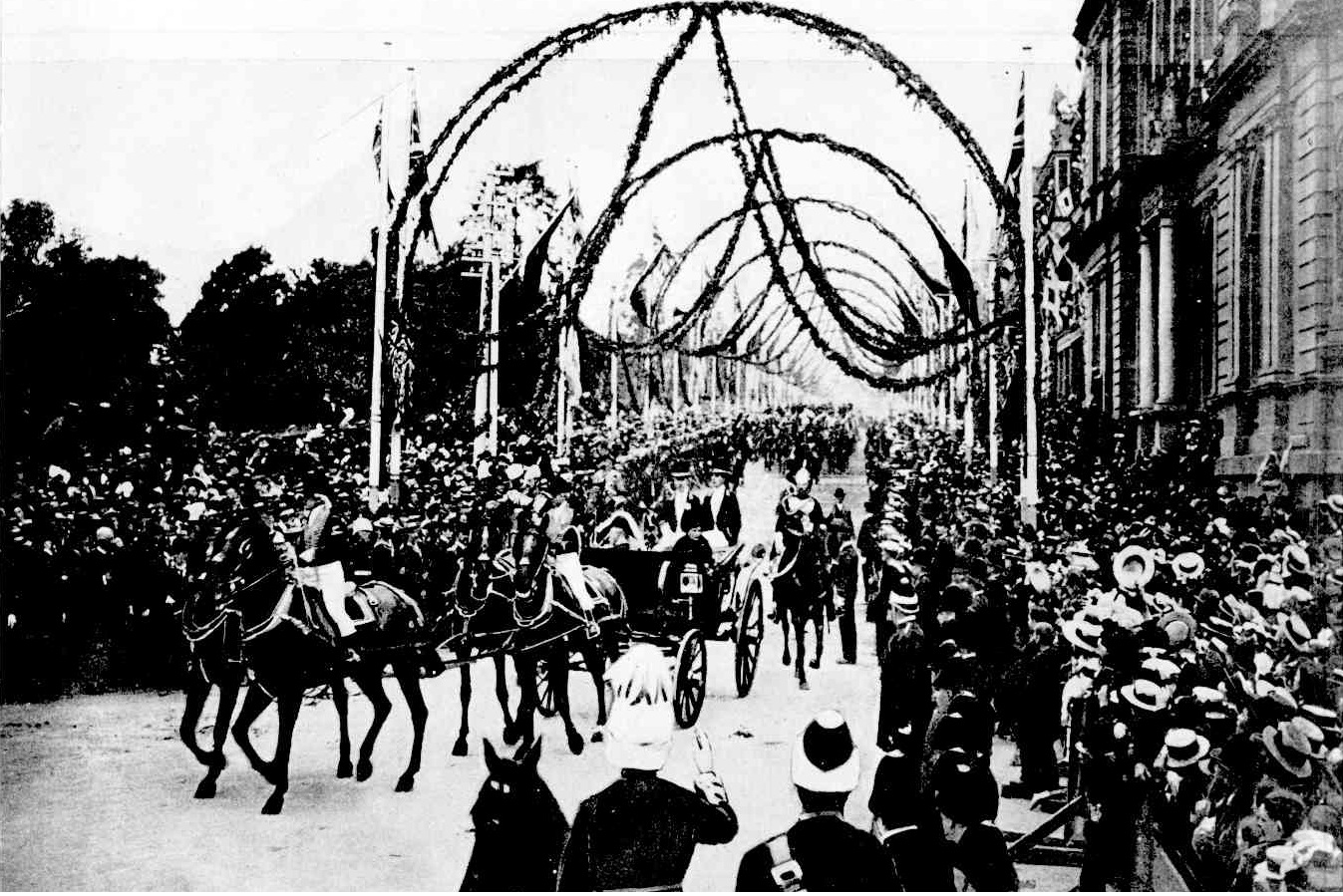
The Procession in Macquarie-street, Sydney-The Royal Carriage Passing the Colonial Secretary's Office. (Photo, by G. A. Hills, 82 King-street.)
The Royal Visit.—The Duke and Duchess in Sydney. A Royal arid Loyal Welcome. (1901, June 1). Australian Town and Country Journal (Sydney, NSW : 1870 - 1907), p. 38. Retrieved from http://nla.gov.au/nla.news-article71467938
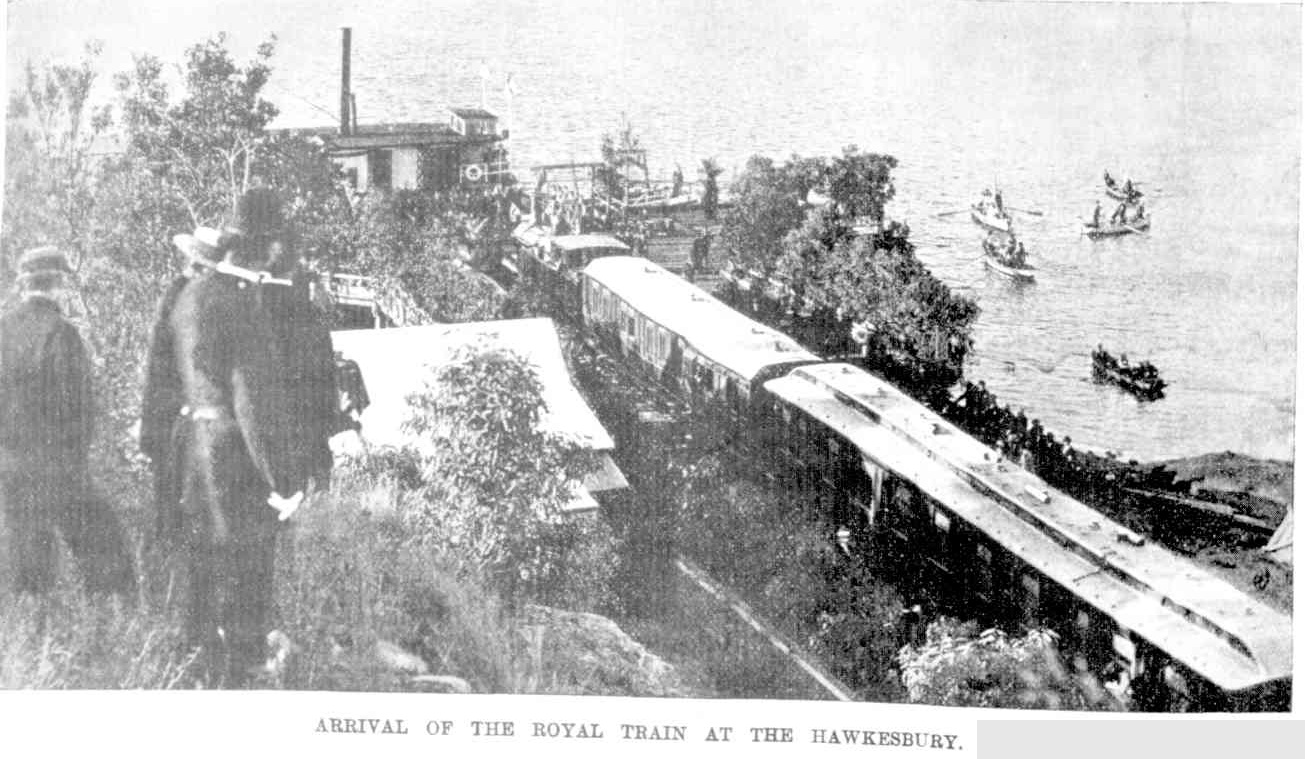
ABUTTAL OF THE ROYAL TRAIN AT THE HAWKESBURY.
.jpg?timestamp=1582942640358)
THE GENERAL GORDON, WITH ROYAL PARTY ON BOARD.
.jpg?timestamp=1582942669151)
ARRIVAL OF THE DUKE AND DUCHESS AT HONEYSUCKLE POINT RAILWAY STATION, NEAR NEWCASTLE, MAY 25, 1901.
No title (1901, June 1). The Sydney Mail and New South Wales Advertiser (NSW : 1871 - 1912), p. 1363. Retrieved from http://nla.gov.au/nla.news-article165294565
THE DECORATIONS AND ILLUMINATIONS.
NEW AND LOVELY EFFECTS.
A BIRTHDAY ON THE HAWKESBURY
The Duke and Duchess spent Sunday very pleasantly on the Hawkesbury. It was the Duchess' birthday, she having been born on May 28, 1867, and a stream of messages came from England and the various States of Australia — congratulating end felicitating her in honor of the event. The Ophir and the Juno were gaily decked with bunting. At noon the Juno fired a salute to the Duchess.
Soon after the salute a party of about 50 from the Ophir and the Juno, including the Royal visitors, boarded the General Gordon, which had gone alongside the Ophir. They made an extensive river trip. Luncheon was taken aboard, tables being laid on the roomy deck of the steamer.
The weather was perfect. A good run was made up the river as far as Milson's Island, when the wind dropped to a dead calm. An awning was then stretched on the sunny side and the steamer was allowed to drift while lunch was partaken of. After lunch the company drained bumpers to the health of the Duchess, who was the recipient of hearty good wishes from all on board. The Duke's health was also honoured.
When the toasts had been drunk, way was got on the steamer once more, and the beautiful reaches of the upper river was threaded 'to a point about three miles above Mangrove. As the fine scenery of the receding bays, was disclosed to view expressions of admiration from all on board were general, and it was conceded that the Hawkesbury is the finest river scenery the visitors have yet viewed.
The General Gordon was turned round above Mangrove, and made an enjoyable run down to Cowan inlet. Again the Ophir was rounded, and Captain Murray took the party for a short trip up Cowan Creek. After a run 'up the Creek the steamer again went alongside the Ophir, and the party once more boarded the anchored liner. Before he went aboard the Duke personally thanked Captain Murray, of the General Gordon, for the services he had rendered, and made him a present of a pair of gold sleeve links embellished with a crown and prose.
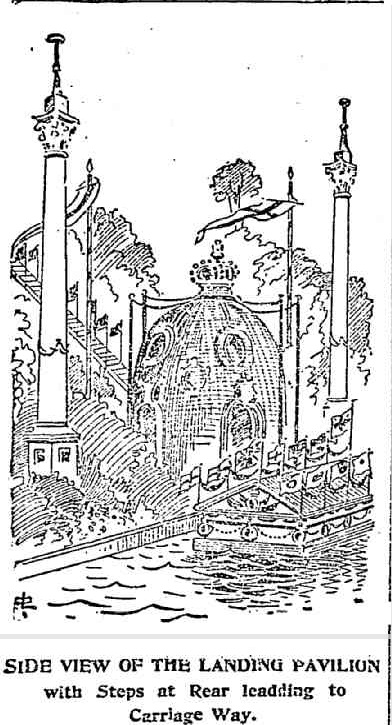
SIDE VIEW OF THE LANDING PAVILION with Steps at Rear leading to Carriage Way.
THE DECORATIONS AND ILLUMINATIONS. (1901, June 2). Sunday Times (Sydney, NSW : 1895 - 1930), p. 9. Retrieved from http://nla.gov.au/nla.news-article125880259
_(14577643037).jpg?timestamp=1582940364147)
Illustration is from The web of empire : a diary of the imperial tour of their Royal Highnesses the Duke & Duchess of Cornwall & York in 1901 / by Sir Donald Mackenzie Wallace, published 1902 - available to read online through the Boston Public Library HERE
Text Appearing After Image:
In the export trade Newcastle has to compete, of course, with Sydney,which is distant only 60 miles by sea and 100 by rail ;but the enterprising citizens believe that their port can hold its own against its elder rival, and they quote in support of their opinion the fact that its tonnage often exceeds that of the Capital. Before I have exhausted this interesting topic with my new acquaintances, their Royal Highnesses return, and we go on by train to the Hawkesbury River, where the Ophir is waiting for us. Here we are to remain quietly till Monday morning.
Sunday, 26th May. — This is a day of rest preparatory to the Sydney functions and festivities, which are to begin to-morrow and last ten days. After the ordinary morning service we go on board a local steam-wheeler called the General Gordon, and make a pleasant little excursion up the river. If we accept the judgment of the late Mr. Anthony Trollope, we must regard the Hawkesbury as the most beautiful river of the world.
In his opinion it beats the Rhine and even the Upper Mississippi. Perhaps he is right. Tastes differ, and, as the German proverb says, in matters of taste there is no possibility of discussion. Without making any invidious comparisons, I can safely assert that the Hawkesbury is very beautiful, and that it has a peculiar beauty of its own which distinguishes it from the beautiful rivers of other continents. It is said to be 300 miles long, and to be navigable for 70 miles. In its lower reaches it has the appearance of a labyrinth of salt-water creeks, which wend their tortuous way among rocky, scrub - covered hills.
Again and again the traveller has the impression of being in a narrow lake without any outlet, until the experienced pilot, who knows all the intricate twistings and turnings by heart, unexpectedly finds an exit, and the little craft glides slowly into another narrow lake of the same kind. The rocky hills, as we see them, cannot have changed much in appearance since they were first seen by the white man more than a hundred years ago (Governor Phillip in 1789), for they are still in a state of nature. At long distances we see on the bank a house with a little enclosure ; but there are no clearings on a large scale, and there are few places where a clearing would be profitable for agricultural or even pastoral purposes.
The less precipitous slopes might be utilised for the construction of country-houses or villas, but I hear that the Government has decided to prevent this kind of settlement by transforming the most picturesque part into a great recreation-ground for the benefit of future generations, under the title of the National Park for North Sydney.
This is the Duchess's birthday. At the close of dinner, therefore, her health is proposed ; earlier in the day an order had been given to " splice the main brace " for the benefit of the crew.
Monday', 26th May. — At 8.15 the Ophir gets under way and slowly wriggles, in serpentine fashion, out of the estuary, which has had to be temporarily buoyed in order to obviate the danger of running aground on the slimy bottom. Our cruisers, the St. George and the Juno, are waiting outside ; and a little farther out we meet the Australian Squadron, which fires, as it approaches, the customary Royal salute — the coils of white smoke from the big guns standing out boldly against a dark background formed by the clouds of dense black smoke from the funnels. Soft Australian coal may be not well adapted for naval purposes, but it has produced for once a strikingly picturesque effect.
As soon as the ships of the Squadron pass the cruisers they wheel round and fall into two lines astern, so as to form a supplementary escort. For an hour or more we steam southward along the precipitous coast, and then, wheeling round to the east-ward, we pass between the famous lighthouse-capped Heads, which an Australian writer has described as "those ancient water-gates of a Continent, through whose imposing portal first poured into the land destined to become the New Britain of the Southern Hemisphere the rising tide of European population."
This means in plain language that the Heads form the entrance of the spacious Port Jackson, the harbour of Sydney, which was long the only port of arrival for emigrants to Australia. To-day they are looking their best, rising majestically against the clear blue sky, with the long swell of the Southern Pacific breaking in foam on their base. The grey clouds which had been hanging over us all morning have kindly dispersed at the right moment, and we see before us the beautiful harbour in all its loveliness, a broad winding inlet, into which jut on both sides a series of gracefully outlined, well-wooded promontories. The Sydneyites have reason to be proud of it, for it would bear a high reputation for beauty even in a more picturesque continent.
Just inside the Heads, on the skyline near the North Cliff, a long row of the unfortunate victims of quarantine regulations cheer the Ophir as she passes, and then the city begins to open up gradually in the distance. The cruisers and the ships of the Australian Squadron are now following us in single file, and the city comes more and more into sight. Suddenly from behind a promontory on the starboard bow the Gromovoi, the Russian cruiser which we met at Melbourne, fires a salute, which is followed up by a salute from the other war-ships and the batteries on shore ; and a volunteer flotilla of steamers, yachts, rowing-boats, and outriggers escort us to our moorings in Farm Cove, in front of Government House, a castellated building half hidden by trees in a spacious park.
It is not yet noon, and the official reception is fixed for 2 o'clock, but the dense crowds on the shore of the little bay in which the Ophir is moored and on the heights above wait patiently for the next item of the programme. Punctually at the appointed time, under a salute from the war-ships, fully dressed and manned, the 1 4- oared barge with the Royal Standard at the bow glides smoothly to the landing-stage, greeted by the enthusiastic cheers of the assembled multitude. In the beautifully decorated pavilion erected for the occasion are collected the State and civic officials, among whom we recognise a goodly number of Melbourne acquaintances — Lord Hopetoun with his staff, Mr. Barton, the Federal Premier, with several members of his Cabinet, and many others who were present at the ceremony of the opening of the first Federal Parliament. The customary presentation of addresses and reply are reserved for another time.
With very little ceremonial, therefore, their Royal Highnesses and suite take their places in the carriages and drive in procession by a long zigzag route through most of the principal streets to Government House.
Sydney is a very different town from Melbourne. Unlike its young rival, which was built rapidly, according to a preconceived, grandiose plan, on a great plain sloping down gradually to the sea-shore, the mother of Australian cities grew up slowly on the hilly promontories which jut out into Port Jackson, content to adapt herself to the irregular topographical conditions and the actual wants of the inhabitants, without attempting to look very far ahead into the uncertain future. Hence there is about the place an old-world look, which has been perhaps not without influence on the general character of the population.
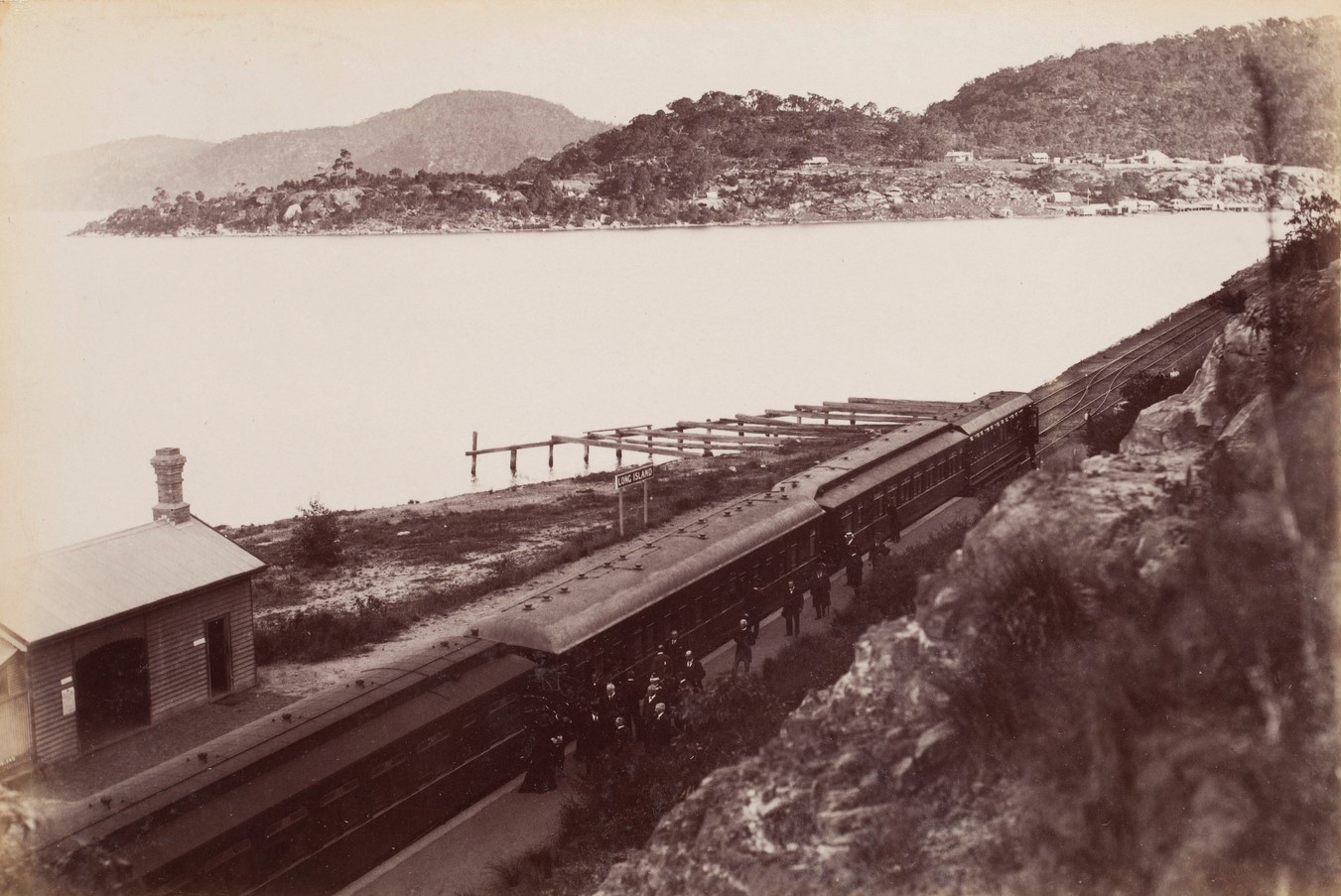
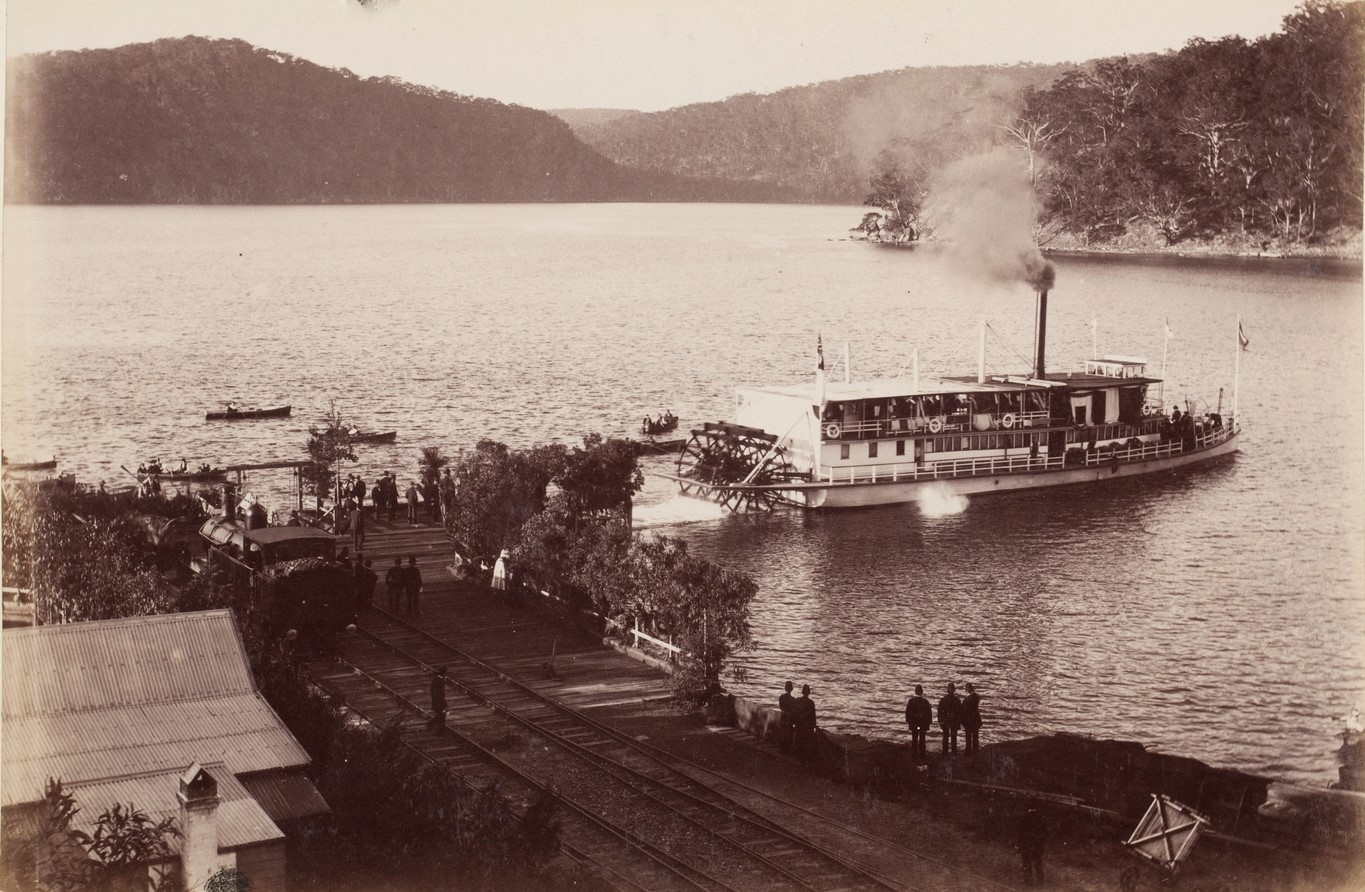
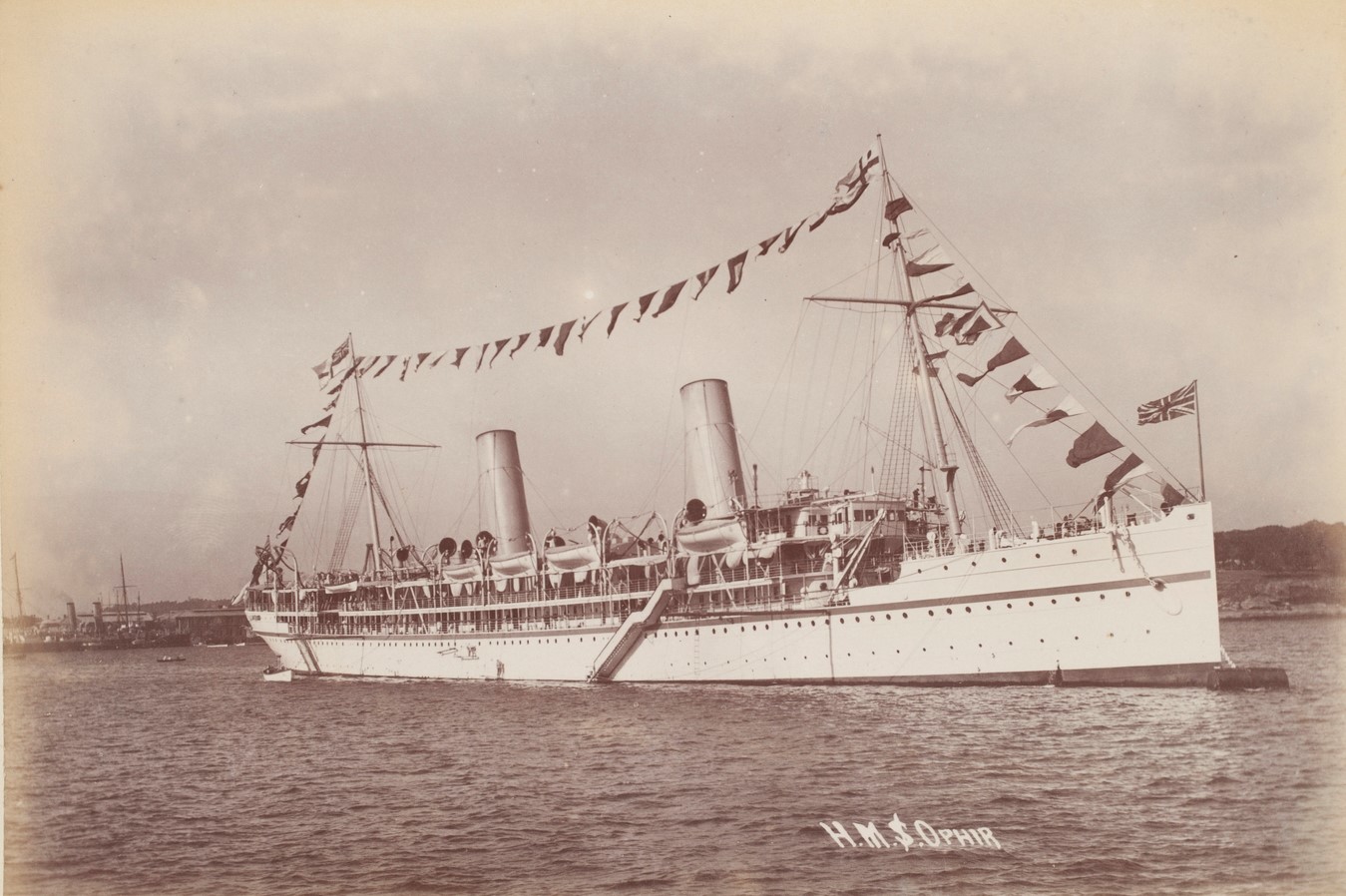
From Album of photographs relating to public celebrations of Australia's federation on 1st January 1901. Items: c004960129h, c004960130h and c004960125h (HMS Ophir, courtesy State Library of NSW - whole Album available online at HERE
This was not the first time the Duke of Cornwall and York had been to the Hawkesbury and Pittwater. The Newport wharf/ pier/quay was originally named ‘Victoria Wharf' in documents prepared and published for the next phase of Mr Jeannerett’s ventures, probably due to a visit by Queen Victoria’s sons, Princes Albert and George (later King George), who were sent as naval cadets on HMS Bacchante for a three year world tour of the then British Empire.
They visited Newport in 1881 and an excursion they were taken on up the Hawkesbury River departed from Newport wharf:
On the 1st August a party from Government House and the Detached Squadron made an excursion up the Hawkesbury and fortunately the weather was so fine that every lovely scene on the river appeared to the best advantage. The Royal Princes were of the party. At an early hour those engaging in the excursion left Man-of war Stairs, and proceeded in the steam launch Nea to Manly, whence they were conveyed by Mr Boulton's coaches to Newport. There they were received by Mr Jeannerett on board the steam launch Pelican.
Barrenjuey was passed about 11 o'clock, the boat then proceeded up the river. The day being beautifully clear, the scenery of the Hawkesbury was seen to the best advantage and was very much admired. Wiseman's Ferry was reached about 3 o'clock in the afternoon. The Pelican stopped at the wharf for a few minutes, and on-the Princes appearing the residents assembled, and an address of loyal welcome was read and presented to them by the master of the Public school, on behalf of the inhabitants of the village. The school children sang the National Anthem ' and those assembled then gave three hearty cheers for the Queen and the Princes. Prince Edward acknowledged the compliment in a few appropriate words. The Pelican resumed her journey, and went up the river as far as Sackville Reach, at which spot the party disembarked and drove thence to Windsor, returning from Windsor to Sydney by special train at night. The Princes slept at Government House on August 1, and on Tuesday took part in tho ceremony of laying the foundation stone of the pedestal for the statue of her Majesty the Queen which will be placed in the circular reserve at the top of King street, near St James s Church. THE ROYAL PRINCES IN SYDNEY. (1881, August 11). The Sydney Morning Herald (NSW : 1842 - 1954), p. 9. Retrieved from http://nla.gov.au/nla.news-article13492318
After just ten days in glorious Wintering Sydney the Royal couple were on their way to New Zealand, with these parting words to the newly born Commonwealth of Australia:
A FAREWELL LETTER.
TO THE PEOPLE OF THE COMMONWEALTH.
The following has been handed to us for publication: —
'Government '
Government House, Melbourne,
July 29, 1901
'Sir,— I have the honor to transmit to your Excellency a copy of a letter which I have received from his Royal Highness the Duke of Cornwall and York, and shall be glad if you can see your way to have the purport of this letter published in the newspapers in the State of New South Wales, on the 1st of August, in order that a simultaneous report may appear in the newspapers of each State on the morning of that day. — I have, etc.,
(Sgd.) HOPETOUN, Governor General.
'His Excellency the Lieutenant-Governor of the State of New South Wales, Sydney.'
H.M.S. Ophir,
Perth. West Australia,
July 20, 1901
Dear Lord Hopetoun, — The time has now arrived when we must take leave of the great island continent over whose destinies you preside, and the principal object of my mission has been accomplished. I am proud to have been entrusted by the King with that mission, in accordance with the wish of my beloved grandmother, and to have had the honor of presiding at the inauguration of the first Parliament of this newly-constituted Federation. The never-failing pleasure and interest which the discharge of our duties gave to the Duchess and myself will remain fresh in our memories, and we shall live in the recollection of those memorable and stirring days which, witnessed the celebration of Australia's new political birth.
I would ask you to kindly make known to the Prime Minister of the Commonwealth and to the Premiers of the several States, through then respective- Governors and Administrators, and to the whole community, our warmest thanks for the hearty greetings and manifestations which have first moment that we set foot on your shores. To the several Governments we desire to express our sincere gratitude for everything -which has been done by them to conduce towards our comfort, convenience, and enjoyment. I would specially refer to the excellent arrangements made for our long journeys by rail, the accommodation for which surpassed any that we have ever before experienced. We are greatly indebted to all the officials and employees, whose work must on these occasions have been excessive, and we trust that the public generally did not suffer from the dislocation of the normal working of the railways. The police arrangements were everywhere carefully conceived and carried out with marked tact and ability, though on all occasions I noticed with pleasure how light were the duties of the police in the streets, where order seemed to be a natural instinct among the vast crowds which thronged them. The Post and Telegraph Departments displayed the greatest attention and courtesy in dealing with what, I fear, was no inconsiderable addition to their ordinary duties.
During our stay in the different States, I had the pleasure of reviewing the forces of the Commonwealth, numbering upwards of 25,000. Everyone must have been impressed by the splendid display of fighting material available in Australia. The number on parade, and the cheerful willingness with which the volunteers assembled, often travelling long distances at no little personal inconvenience, gave proof of that fixed readiness to defend the national interests whenever and wherever they may be threatened, which has been declared so unmistakably throughout the Empire. I feel certain that immeasurable advantages must accrue to the military organisation of the Commonwealth by its being brought under one central administration. I look upon it as a great privilege and pleasure to have had the opportunity of seeing, and, in the King's name, presenting medals to the officers and men who have- returned from the seat of war, and I have noted with much satisfaction the enthusiasm with which they have been received by their fellow-countrymen. I have been much interested in the. cadet corps, may of which were particularly smart, soldier-like in their bearing, and well equipped. I am confident that the great importance of securing thoroughly efficient instruction for these corps will not foe lost sight of by the responsible authorities. It seems to me that in this excellent movement lies a strong power for good, for besides the benefit of a physical training it inculcates into the coming generation that spirit of subordination and esprit de corps so essential, not merely in the soldier, but in the development of the national character.
I have realised with much satisfaction that a sound and practical education is placed within the reach of all, and that the opportunities thus given by the State are fully taken advantage of by the people at large. At the same time, the great importance of physical training is not lost sight of, and I had the pleasure of seeing not only the drill of the cadets, but also admirably executed physical displays by the school children in the various States.
The Duchess and I feel that we cannot adequately thank Lady Hopetoun and you for your generous hospitality, for your unfailing kind attention, and for the manner in which you anticipated our wants, and personally supervised all the arrangements of our visit. Our cordial thanks are due to your excellent staff, for the untiring patience and kindness in carrying out those arrangements, and for their valuable and ready assistance to me and my staff. To the Governors and ' Administrators of the several States, and to their staffs, we desire to express our sincere thanks for the similar kind and thoughtful consideration which, we received while their guests, and our deep. appreciation of the spirit in which all the trouble and inconvenience of entertaining so large a party was met. We leave with many regrets, mitigated, however, by the hope that while we have gained new friendships and goodwill, something may also have been achieved towards the strengthening and welding together of the Empire through the sympathy and interest which have been displayed in our journey, both at home and in the colonies. The Commonwealth and its people will ever have a warm place in our hearts. We shall always take the keenest interest in its welfare, and. our earnest prayer will be for its continued advancement, not only in material progress, but in all that tends to make life noble and happy.
Believe me, dear Lord Hopetoun,
Most Sincerely Yours,
(Signed) GEORGE.
THE DUKE AND DUCHESS (1901, August 1). Evening News (Sydney, NSW : 1869 - 1931), p. 5. Retrieved from http://nla.gov.au/nla.news-article114028885
On September 9th 1901, the Countess of Hopetoun, wife of the Governor-General, announced the winners of a competition to design the Australian National Flag. A large flag, 5.5 metres by 11 metres, was unfurled and flown over the dome of the Royal Exhibition Building in Melbourne.
So next time you find a medal with '1901' on it, take a closer look - you may be holding something that was there at the birth of Australia as a nation.
References And Further
- TROVE - National Library of Australia
- The Mitchell Library - State Library of New South Wales
- Powerhouse Museum, Sydney - MAAS
- Museums Victoria Collections
- The State Library of Victoria
- The Newport School: 1888 To 2018
- Church Point And Bayview: A Pittwater Public School Set On The Estuary: 1880 To 2016
- Pittwater’s Parallel Estuary: The Cowan ‘Creek’
- Newport Wharf - History
PUBLIC SCHOOLS' DISPLAY, SYDNEY CRICKET GROUND, JANUARY 3, 1901.
THE SYDNEY PAGEANT.
BRILLIANT WEATHER. MAGNIFICENT DISPLAY.
From Our Special Reporters.
SYDNEY, Tuesday.
The Australian Commonwealth was inaugurated in Sydney to-day. The old century went out amidst rain and storm; the new one made its advent amidst overhanging clouds and portending thunder. Disunity and parochialism made a tearful exit. Federated Australia was nevertheless ushered into being on a day that was full of sunshine and inspiration of life and hope and the spirit of buoyant youth. The whole of the day's celebrations were a brilliant and complete success. But if the heavens had opened and the streets hod been converted into sweeping torrents the Federalists of Sydney would not have been robbed of the fetes and ceremonies of to-day. i Beneath the desire for a high holiday there was a joyous and deep seated sentiment in connection with the proceedings that would have found expression in spite of the convulsions of the elements. The sun burst forth through overhanging clouds at 10 a.m. His beams were never before half so welcome. The crowds begun to thicken at every point and to assume a gayer garb. Whites and pinks and blues came instead of blacks and browns and greys. An invigorating, southerly breeze sprang up. The flags, the streamers, the great cataracts of white, blue, yellow and red silk and muslin which seemed to pour down from top to bottom stories began to glisten in the sunlight and to rustle in the breeze. The flags, no longer limp and listless on their poles, began to show the first flutters of returning life. The great garlands of (lowers on- the arches, in the windows, over the doorways, and, in fact, everywhere, began to perk up their dewy petals, and all paint work and pictures and transparencies glistened in a ' freshened atmosphere. The new nation was awakening, and with it inanimate nature was springing into renewed beauty and life. Altogether it has been a great and momentous day. To look back, upon its features and to attempt to recall them one by one in clear outline is to perform a severe mental effort.
Scenes of dazzling brightness and beauty, the glitter and circumstance of the marching of the world's finest regiments, the great and interesting crowds of people gathered from all parts of the southern hemisphere, the clashing of a hundred brass bands, the singing of a hundred choirs— all these features', and many more, blur the keenness of impression by the apparently limitless scale upon which they were presented. And above all these was the glorious buoyancy of everything, the grandeur of the sentiment which seemed to permeate the people and the joy-ousness of everything and of everybody.
During' the last week or two, as the decorations have gradually grown in pretentiousness, people have begun to marvel at their extent and infinite variety. This morning, as viewed from the procession, the appearance of the city and its people was sufficient to captivate the senses. The start of it all was in the shady Domain, which the rain had clothed with brighter verdure. It wound out slowly under a grand arch of coal, against which the white pennants and flowers glistened like snow. Along by St. Mary's Cathedral 2000 little girls, all clad in white, shook 2000 little handkerchiefs at the gay Dragoons and Lancers. Grand stands reared to a height of 30 feet and 40 feet,' on either hand, and gaily dressed crowds occupied every seat upon them.' Every' one of the people waved flags, threw flowers or sang or cheered. Arches succeeded arches — many of them had never before been hoard of or thought of — in bewildering succession. "United Germany Greets United Australia"; "The United States Welcomes United Australia'’; "We Welcome in Unity Our Comrades from Over the Seas" — these were some of the thousand mottoes which breathed the spirit of unity and universal brotherhood; At times, as the two miles of pageant — it took 55 minutes to pass a given point — slowly coiled along to the park, the galleries . and grand stands rose on either hand so perpendicularly that the living walls appeared to be like the sides of Lome great excavation hewn into a mountain of- living people, along, the depths of which the march was travelling.
How bright and how gay were all those happy' sightseers! How many pairs of bright eyes were dazzled at the grandeur of the spectacle, and how many, voices cracked into all sorts' of ridiculous sounds in wild endeavors to keep up the cheering? The flags, the flag poles, the wreaths and garlands of flowers were clustered so thickly in the streets and upon the buildings that for moments together everybody and everything was lost in a hundred tinted wave of color. The crowds thronged footpaths, stared from every window, appeared to be crushing, each other to suffocation in every balcony and upon every roof, and hung from every niche and projection like myriads of insects. But the crowd was contented and apparently happy to pay in discomfort any price for the honor and the privilege of being present at so great a ceremony. At least one who was expectant and self-congratulatory was doomed not to see the events of the next few minutes. A trooper's horse bolted, a woman was dashed to the ground, stunned and bleeding, and the rider himself was also carried away crushed and blood-marked. There were other incident's that were fortunately not so tragic.
As the procession had passed through the streets the processionists had noted a large picture of Sir Henry Parkes, bearing the words, "Iliad to rise again to see a day like this."' A similar picture now appeared amongst the crowd on the hill, and it was probably due to the good taste of the throngs that it attracted little or no attention. There was so much of interest and of beauty along that triumphant pageant that human eyesight lamentably lost its range.
Attention was arrested within a few yards, and all the miles of people and flags and flowers beyond were comparatively lost to view owing to the attractiveness of the detail near at hand. A mile of waving plumes, of glittering lances, of giant bobbing busbies, of prancing horses, of stately plumed life guardsmen, with flashing helmets and breast plates; of swarthy Maories,', sitting' great lean horses like statues; of romantic looking Indians in gorgeous Oriental costumes; of thickets of swords and lances— these were the main features of the procession as a spectacle. The sight of those walls of stately troops in all the circumstance of glorious war stirred the hearts of the people until their senses were whirled away with their excess of exuberant feeling. They laughed and cheered, and kept on cheering, while some of them wiped away tears which they could not explain, 'for there was no explanation other than the overwhelming excess of patriotism, of loyalty and of kindly feeling. Spectacularly it was grand, but it was something more. Band after band stepped out, in front of the different regiments of soldiery, and played away at all the songs that the people love, until half of the crowds were singing in delightful abandon while the other half were cheering. After one of the best of these bands— that of H.M. Royal Arthur— and marching proudly to the tune of Sons of the Sea, came the naval men, the sturdy fellows of the Australian Squadron. How delightfully free and careless, but how strong, bold and manly, .did Jack look today, and how proud the people seemed to own him as their defender! To the music of bands and also spontaneous vocal efforts must be added the singing of the children's choir at St. Mary's Cathedral. There the 2000 little girls in white already referred to chorussed in the delightful melody of childhood's voices, and lent a charm to the proceedings that was perhaps as ennobling as it was delightful. THE SYDNEY PAGEANT. (1901, January 2). The Age (Melbourne, Vic. : 1854 - 1954), p. 5. Retrieved from http://nla.gov.au/nla.news-article196062016
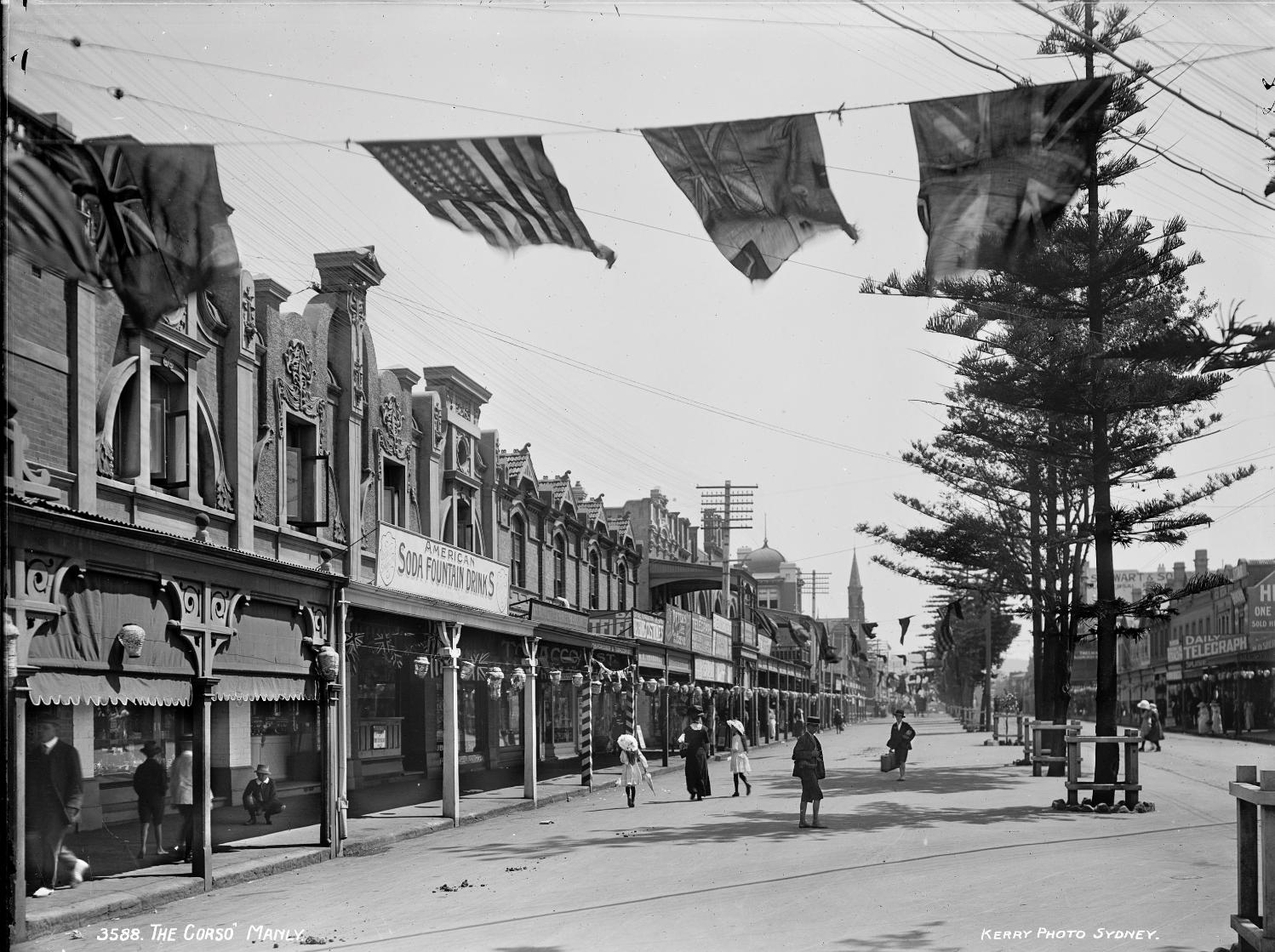
Glass plate negative, ‘The Corso, Manly’, by Charles H. Kerry & Co, circa 1908 - This image shows Manly Corso looking west towards Manly Cove (where the ferry arrives) in about 1908. Australian, American and British flags are flying in the foreground of the image. It is possible that the flags mark the arrival of the Great White Fleet of the United States Navy in 1908. This photographic negative was published by the Sydney firm Charles Kerry & Co. and is part of the Powerhouse Museum's Tyrrell collection which contains over 2,900 glass plate negatives by Kerry & Co.